GURPS Voodoo: The Shadow War by Fossilized Rappy
Intro
Original SA post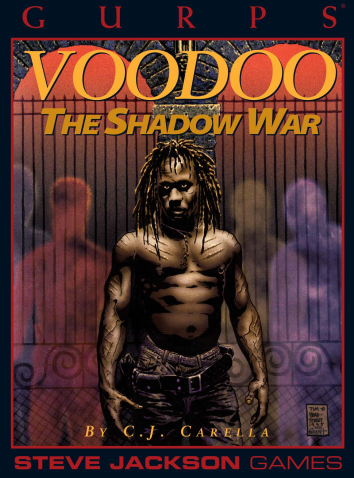
I only just noticed how the kerning on the Third Edition GURPS logo upsets a broken part of my brain.
While things aren't quite ready yet for the next chapter of the Conspiracy X saga, I wanted to put out something for the thread, so I went back to the GURPS mines.
As I've noted before, GURPS Third Edition was a wellspring of weird and wondrous setting opportunities. Steve Jackson Games roped in licenses for everything from the 90s hearthrob that was the World of Darkness to atypical choices such as Bunnies and Burrows, Uplift, and Callahan's Crosstime Saloon. At the same time, freelancers for the company were working on new GURPS-original settings that included Reign of Steel, Technomancer, and Transhuman Space (which I plan on getting to one day, but that's a big setting to chew through). One such setting was GURPS Voodoo: the Shadow War, created by C.J. Carella and published in 1995. You may recall from Alien Rope Burn's odyssey through RIFTS that Carella is the man who blessed us with psychic capybara-men. Other GURPS works Carella wrote were GURPS Imperial Rome, GURPS Martial Arts, and GURPS War Against the Chtorr. He is also the creator of the Unisystem roleplaying game system, having penned its first iteration for his roleplaying game WitchCraft and worked on later Unisystem titles such as All Flesh Must be Eaten, Terra Primate, and the Buffy the Vampire Slayer Roleplaying Game.
So, why pick GURPS Voodoo for the thread? A few reasons. For one, at 128 pages counting indices and the like, it's not an overly long book. GURPS Voodoo is probably one of the more fair-handed looks at Voudou and Santeria in roleplaying games (though this is admittedly not a terribly hard feat). It also has had a lasting effect on GURPS itself, creating the first incarnation of what would become one of the most popular magic systems in GURPS Fourth Edition. Most important of all is that it has the same odd uniqueness that drew me to cover GURPS Technomancer, and there are some really fun ideas in here about incorporating Caribbean syncretic religions into an urban fantasy environment without losing the distinctive flavor of voudoun and company.
On the flip side...
quote:
The Corruptors prefer politicians whose words and actions will inspire chaos and violence. Their camp includes ultra-conservatives and revolutionaries, racists (and reverse racists), misogynists and radical feminists, fundamentalists railing about “Satan-spawned” ideas and secular humanists undermining spiritual concepts.
...it's also very....
quote:
The serial-killer problem is much bigger than even the most fanciful criminologists would have us believe. Over a thousand of these murderers plague North America alone, and many more are scattered around the world. Only a handful are caught every year.
...very...
quote:
From a supernatural point of view, slavery was one of the worst cases of human sacrifice in history, topped only recently by the Holocaust. The fact that most of the perpetrators were unaware of what they were doing did not help in the slightest. The sacrifice acted as a titanic summoning ritual, and evil entities answered the summons by the thousands.
...very 90s, both in writing and in artwork.
Oh, and there will be cat people. There's always cat people.
Next Time: Voodoo Priests and Asshole Wizards.
"...Undoubtedly, you will think these the ravings of a lunatic"'
Original SA post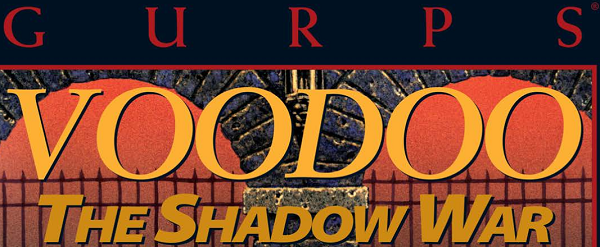
Part 1: "...Undoubtedly, you will think these the ravings of a lunatic"'
Introduction
quote:
The world of GURPS Voodoo: The Shadow War is not unlike our own. Innocent people are victimized by criminals, governments and other predators that can be called “human” only by a stretch of that word’s definition. Illegal drugs are an industry that produces more money than the GNP of many nations, and 12 years of the so-called “War on Drugs” have not come close to solving the problem. The “artworks” of serial killers are displayed in galleries, and murderers go free. But in the world portrayed in these pages, those crimes, wars and natural disasters are all pieces of a puzzle — moves in a planetwide game with the souls of humankind at stake.
...And that part of the introduction “chapter” about sums up the whole introduction. Moving on.
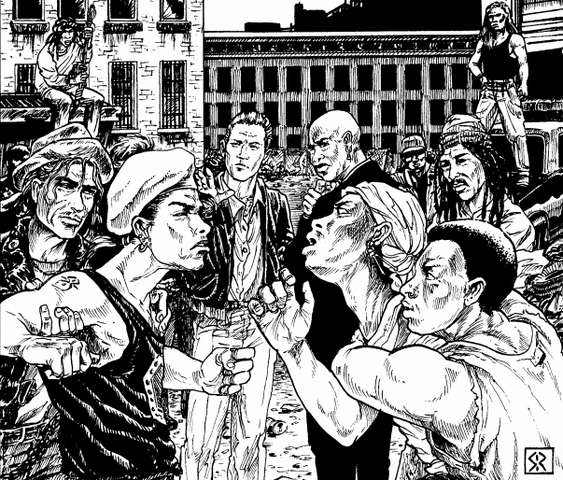
Chapter 1: The Shadow War
As this is a fantasy roleplaying game title in the 90s, GURPS Voodoo starts off with a page and change of introductory fiction. It gives us the last minutes of a man named Deveraux, a member of Columbia University's anthropology department. After the death of his wife and child due to an unstated supernatural fate, Deveraux delved into the supernatural truth of the world, learning of the tremendous threats to humanity therein courtesy of the ravings of a straight-jacketed Haitian woman in an insane asylum. As he sends out his collected works in the hopes some other staff members will take the path to enlightenment, a monster he calls the Smiling Man appears wearing Deveraux's face, rips said face off while giving a manic grin, and then murders the real Deveraux.
After the introductory fiction, we get a few disclaimers. We are forewarned that the book is heavily entwined with the topics of racism and slavery, told that while the Voodoo cults (see below) are real practiced religions the magic spells inside here are not in fact actual real world rituals, and given a warning featuring Steve Jackson Games's favorite Discordian meme:
quote:
All the conspiracies mentioned in the book are the products of the author’s fevered imagination. They are not meant to describe actual institutions or organizations, and any resemblances are purely FNORD.
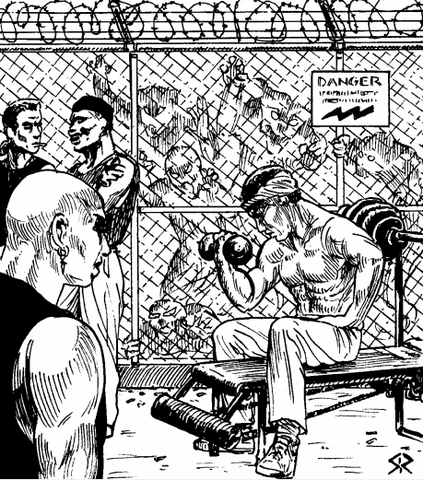
Behind the Facade
Moving into introducing the setting in more detail than the introduction, we are told that GURPS Voodoo is a world wherein spirits are very real and very much a part of everyday life. Knowledge of these spirits has been intentionally suppressed in Europe and "Western" cultures, keeping the power of magic in those regions held in the hands of a select few secret societies known as the Lodges. The powers that be allow science to grow, but keep religion and metaphysics stagnant, and also take time to discredit non-Western magicians as being primitive superstitious folk. Fear not, however! We are told that "the old ways" are thankfully not dead, as Voodoo (used here to collectively refer to various Caribbean and Latin American rites with a syncretic mix of European and west African religious traditions) stands firm in the Americas.
The ability to deal with the spirits is increasingly becoming a very big deal, as the world is spiritually sick. Government corruption, illegal drug trafficking, the decay of urban centers, and escalating violence are all being prodded on by the Corruptors, supernatural evils that feed on humanity's suffering. Corruptors include the Gnostic Demiurge and what Voodoo Initiates refer to as the Mayombe. Everything from the assassination of JFK (it was a black magic ritual) and Castro's rise to power (also black magic) to the creation of the USA and USSR (creations of the Lodges) and the Medieval Crusades (yep, the Lodges) is now pushed into action as part of the Shadow War, the spiritual struggle between light and darkness.
The spirit world itself is the invisible realm dominated by ghosts, angels, demons, and gods. These include both Voodoo patron spirits and the aforementioned Corruptors. Corruptors are created by the psychic resonance of intense negative emotions and gather around similarly negative-charged areas such as wargrounds, concentration camps, prisons, and serial killer hunting grounds. Anyone who can connect with the spirit world is known as an Initiate. Most are Initiated through intense ritual performance and ordeals of the body and soul, but some individuals can be Initiated naturally through certain less than pleasant circumstances. Quoth the book:
quote:
The consciousness of any human being who is exposed to a severe trauma is altered to such a degree that he may accidentally see a world that remains invisible to most of us. Therefore, one can find Initiates in the membership of secret societies or Voodoo temples – and also in insane asylums, concentration camps and other hellholes.
Properly trained Initiates are your magical priests and wizards, capable of performing supernatural feats and manipulating spirits. The two largest producers of Initiates are the Voodoo traditions and the Lodges of "the Western world" (which includes traditional Middle Eastern Judaism and Islam in this case). Other religious and cultural groups have Initiates too, but for the most part they aren't considered important to the setting's focus.
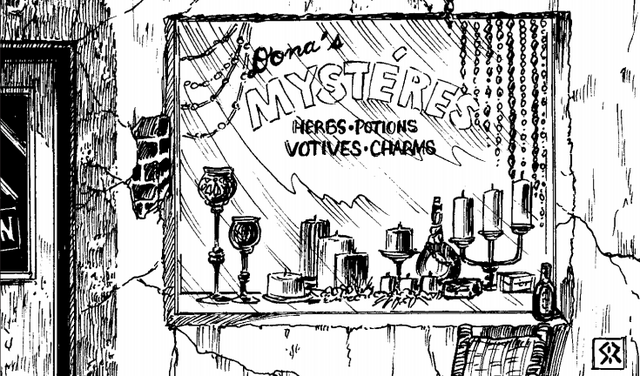
Voodoo
The Voodoo traditions are considered at the center of the Shadow War due to being syncretic practices made up of beliefs from across Europe, Africa, and the Americas, thus giving them a wide breadth of experience...and since, you know, this is called GURPS Voodoo, but now you know the in-universe explanation. The loas, or orishas, are the spiritual beings that are at the center of all the different Voodoo groups. Loas are divided into two categories, the first being old gods from central African traditions that came over with the slave trade or their New World counterparts and the second being lesser loas made manifest from spirits of dead humans. Just what the loas are is contentious among the Initiated: some claim they are merely the psychic effects of the collective unconscious made manifest, others believe they are genuine gods and demigods, and still others claim that they are spirits that intercede between humanity and the one true God (such as in the Catholicism-based world of Louisiana Voodoo).
Traditional Voodoo Initiates typically take either the path of priesthood or become black magic practitioners for hire known as bokkor/bokor or palo mayombes. These are a relatively small number amidst the millions of believers in the Voodoo religions, most of whom know little or nothing about the Shadow War, the Lodges and their machinations, and the looming threat of the Corruptors. Even Initiates don't always know everything, as the vast majority believe In-Betweeners (monsters, essentially, so called due to the fact that they are "in between" the material and spiritual realms) to be superstitions and myths. The main exception to this are the people of the more primitive (the book's word choice, not mine) parts of Haiti and the other Caribbean islands, where communities have more open encounters with the supernatural and know enough about In-Betweeners to hunt them down when they show up.
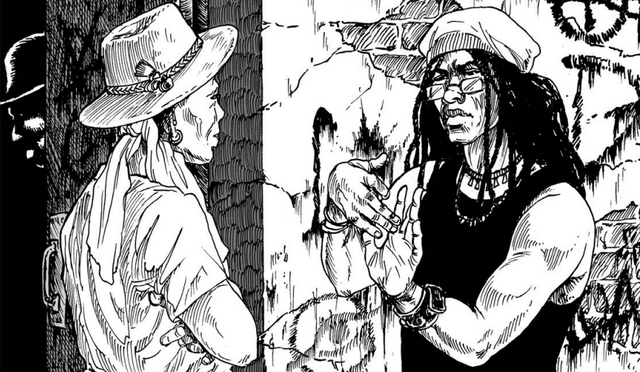
Voodoo Cults
It turns out that different religions in different parts of a diverse cultural region are, in fact, different! While they may all be gathered under the Voodoo brand, the disparate Voodoo traditions all have their own beliefs, certain unique loas, and often disagree with one another on various matters both material and spiritual. Two of these are real world religious sects, while the other six are both traditionalist and modern secret societies.
Voudoun: This is your “traditional” Voodoo, the one you're probably thinking of when you hear the word. Voudoun was birthed on the island of Haiti, and has since spread to other portions of the French Caribbean, French Guyana, and Haitian enclaves in the United States. The rough economic history of Haiti, combined with the rule of tyrants such as Francois "Papa Doc" Duvalier, have made many Initiates of other Voodoo traditions suspicious of Voudoun practitioners on site, believing that the whole Haitian people have been influenced by the Corruptors ever since they won independence from France. This is definitely the case with almost all priests that have been in positions of power in the country, but most local village houngans and mambos (male and female Voudoun priests, respectively) care deeply about their communities. It's implied that if they were less isolationist, however, they could become a force of good for all of Haiti and stop being curbstomped every time a dictator with some tainted houngans in tow came to power.
Santeria: This Voodoo sect is found in Brazil, Colombia, Cuba, the Dominican Republic, and Venezuela, having roots in the mixture of Yoruba culture with that of Spain and Portugal. Santeria has more white and Hispanic representation than the mostly black Voudoun due to its differing regional origins, but has also had to deal with more shit from the Lodges than the Voodoo Initiates in Haiti. A Santeria priest is referred to as a santero, with high priests in particular being known as babalawos. A babalawo has aspects of both teacher and godparent in the role they take concerning lower their santero pupils. Balawos are even forbidden from romance with those they teach, as it would be seen as spiritual incest and offend the orishas.
The Lucumi: Certain very private Voodoo fraternities, known as bizongues in French-speakings areas and cabildos in Spanish-speaking ones, gather together to take direct action in the Shadow War on one of the two sides. Three particular bizongues are detailed here, the largest being these guys. The Lucumi can match a European Lodge in size, and were born out of Initiates conducting meetings and in the dream world and finding that the future could unfold in two paths:
quote:
The Voodoo priests saw two different possible futures: one in which children of all races worked in harmony, mixing their blood until no one race dominated – and another where white slaughtered black and vice versa, where genocidal wars shattered civilization and humankind was lost in a sea of hatred and self-destruction.
The Dahomets: Members of this bizongue are descendants of soldiers of the Dahomey Kingdom that were brought to Haiti by King Henry Christophe in the 1810s. They're pretty much assassin wizards, combining their knowledge of magic and weaponry to kill people quite well. They worship either an unnamed and particularly assholish loa or straight up serve a Corruptor.
The Leopard Society: The bizongue known as the Leopard Society was originally created by descendants of the Egbo, a west African secret society with the leopard as its symbol. While they are masters of the typically bokor-oriented arts of poisoning and zombie creation, they use these and their other talents only against Corruptors, Lodges, and In-Betweeners. A less savory splinter faction was created by Papa Doc Duvalier for supernatural terror tactics during his rule, however; these Leopard separatists have now deified Papa Doc as their own patron loa and continue their atrocities in Cuba at the behest of Fidel Castro. The separatists are well known enough that mainstream Leopard Society members don't exactly advertise who they work for, and more often than not pose as free agents.
The Protectors: The Protectors are a group of Initiates in the United States and Canada made up of the children of Cuban and Haitian immigrants. They combine Voudoun religious beliefs with "a Western education and world view", which pisses off traditionalist Caribbean Initiates. Protectors always have their eyes on the Shadow War, engaging in both political activism and supernatural warfare against the Corruptors. As a group, they are willing to work with the Lodges and other non-Vooodoo Initiate societies, as they feel the goal of stopping the Corruptors is far more important than any centuries-old bad blood. Protectors can be from pretty much any background, as the group is "less concerned with racial heritage than with political correctness".
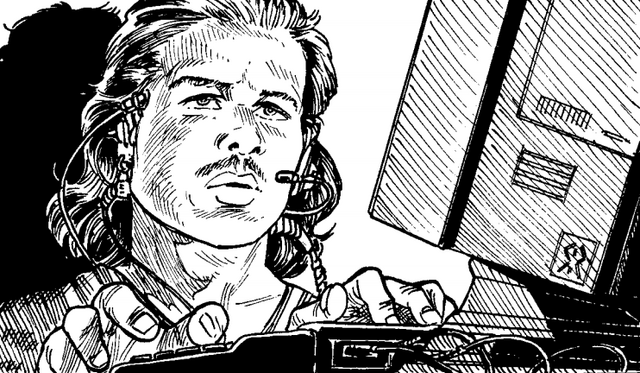
The Electronic Crossroads: Wizard hackers that are probably the most 90s thing in this very 90s book. Members of the Electronic Crossroads have created new magic rituals to crash systems, go into computers as a virtual reality pocket space, and allow spirits to travel through electronic pathways. They use these talents for goals of freeing information, uncovering secrets, helping the weak, and felling the strong. While technically listed as a Voodoo society, members of the EC can be of any magical tradition, and there's a fair number of Native American shamans, Wiccan spellcasters, and Taoist Initiates in its ranks.
The Loa Lords: Actually, I take back my statement about the Electronic Crossroads – these guys are the most 90s. A bunch of inner city kids from black and Hispanic communities, the Loa Lords have suffered from poverty and violence long enough that they want to take down the Corruptors just as bad as the Protectors. Unlike the Protectors, though, these guys aren't political activists. Instead, Loa Lords Initiates are on the streets, using either brute force or subtle maneuverings to take down drug pushers, cartels, street gangs, and the like. While Loa Lords and Protectors will work together, the two groups are on the opposite scales of pragmatism vs. idealism, which tends to lead to grinding gears from time to time.
Next Time: AIDS magic and Klan wizards
"The Ku Klux Klan was their brainchild"
Original SA post
Part 2: "The Ku Klux Klan was their brainchild"
Chapter 1 Continued
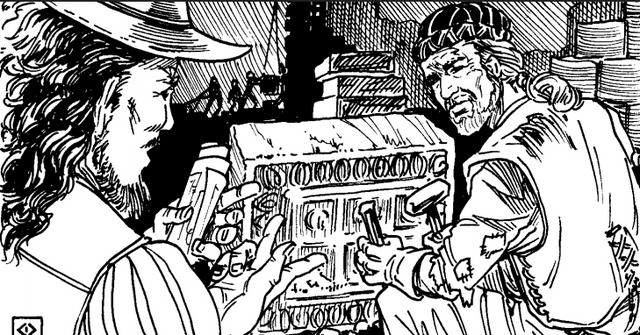
The Lodges
quote:
They call themselves the Lodges. They were the force behind the Inquisition, the Reformation, the Industrial Revolution and most major conflicts and events since before the fall of the Roman Empire. They sabotaged the Ghost Dance, the Boxer Rebellion, and every mystical attempt of magical cultures to fight off European invaders. They have been the secret protectors of Western civilization for 1,000 years, and the secret masters of the world for longer than that.
Assuming their history is correct, the first Lodge was founded during the Roman Empire by Simon Magus, a Samaritan Initiate in the First Century, and spread outward through the adherents of the Gnostic Gospels. From there, the Lodges slowly weeded its way into Roman society and the underground Church alike, having full control once Constantine took the throne as Emperor and declared Christianity the Roman Empire's official religion, removing the possibility of pagan Initiates interfering with the plans of the Lodges in the region. The oldest extant Lodge, the Roman Lodge, came about during this period and quickly gained strength by becoming the puppet master of the early Roman Catholic Church.
The Lodges outside of the Holy City inevitably fell into line as supporters of various polities in Europe such as the Kingdom of France, Kingdom of England, and the Byzantine Empire, as well as the inexplicable Jewish and Muslim Lodges in the Middle East that seem to defy all the logic of the demographics of the Lodges. The Crusades, Hundred Years' War, Protestant Reformation and subsequent wars between Protestantism and Catholicism, French Revolution, American Revolution, American Civil War, World Wars I and II, and the Cold War have all been dick-slapping contests between the Lodges.
It was also the Lodges who sent Initiates along with the colonists of the Americas, Australia, India, and the African continent, neutralizing local Initiates so that their magic couldn't be used to stand against the steamroller of superior Western technology. On the specifically post-colonial American and Caribbean front, the Lodges influenced the Atlantic slave trade, witch hunts, demonization of Voodoo as Satanic, police brutality, militarism, and animal rights activism (it interferes with animal sacrifice to the loas, you see).
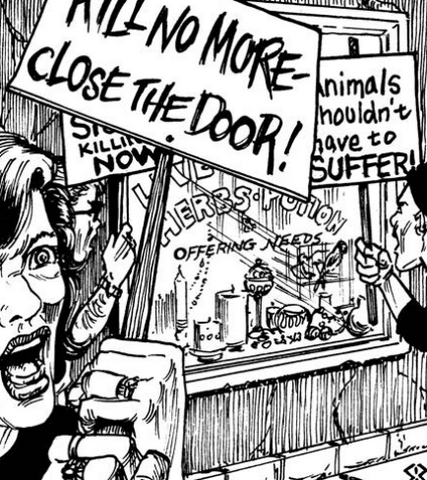
The organizational structure of a Lodge varies depending on the whims of who's running it, but most are split up into cells referred to as either councils or dioceses. Individual members have a rank in the hierarchy that goes from one to ten, typically known as degrees. Heading up a council is an elected tenth degree Initiate known as a bishop, whose power is held in check by the fact that a unanimous vote by all sixth degree or higher members of the council can strip him of his title if he pushes into territory they disagree with. Outside of the actual membership, councils also have puppets in local government, law enforcement, and business unions, as well as groups of hired assassins and legbreakers pulled from ex-military and ex-police if they need to use violence rather than magic to get what they want.
The rulers of all the Lodges are the Secret Masters, the longest-lived and most powerful Initiates of all time. Who are they? Nobody knows, because only tenth degree Initiates of the Lodges can even see them, and they aren't talking. There are rumors, though, and the supposed Secret Masters include Aleister Crowley, Comte de Saint-Germaine, Emperor Constantine, Harry Houdini, Abraham ben Samuel Abulafia, and Simon Magus himself. Some have questioned why the Secret Masters don't just stop the spirit-caused atrocities of the world if they're so mighty, to which traditionalists have shrugged and gone “they work in mysterious ways” and schismatics have yelled that the Corruptors are so thorough that they have even gotten to the Secret Masters.
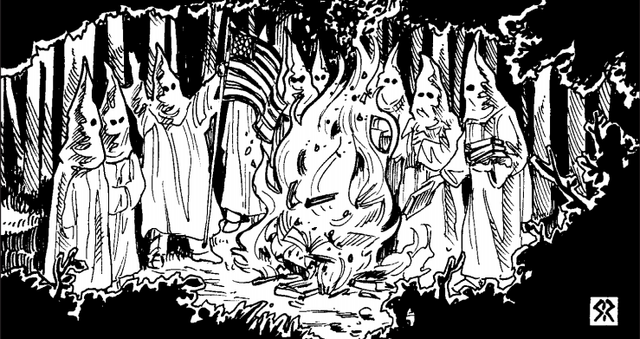
Major Lodges and Other Lodge Orders
As with the Voodoo sects, notes on the three most influential Lodges and a smattering of smaller groups is given.
The Roman Lodge: As mentioned in the discussion of the history of the Lodges, the Roman Lodge is the power behind the Roman Catholic Church. They also happen to control most other fundamentalist Christian sects these days, "including many whose members would froth at the mouth at the suggestion that they have anything to do with Catholics". Roman Lodge members can be split up into three categories. First, there's the ones who genuinely believe that they are the vanguard of the Lord, pious Initiates whose magic is guided toward keeping Christian hegemony and spreading its morality. Second are some Gnostics who are just using the un-Initiated faithful of the Catholic Church and other Christian denominations as a sledgehammer for their own purposes. Finally, of course, there are the "corrupt Initiates", the evil guys who secretly serve the demiurges and other Corruptors. The third category is why pedophile priests exist, as well as why they typically don't get convicted. Regardless of which of the three groups they're in, the entirety of the Roman Lodge's membership is hugely sexist, seeing women as either whores or babymakers.
The Royalist Lodge: Out of numerous Lodges related to specific European kingdoms eventually came the Royalist Lodge. These disparate individuals came together during the time spanning the English Civil War and French Revolutions, as the members of the Lodge realized their firmly held belief in the divine right of kings was being threatened by revolutionary movements across the continent. Once monarchies began to fall out of the style outright, the Lodge went from elitism based on class to elitism based on race. The Ku Klux Klan, for instance, was these guys' creation, which is why the Klan has their ridiculous mystical titles like Grand Wizard and so forth. Unconfirmed rumors suggest they also used magic rituals to create AIDS and spread sickle cell anemia.
The Enlightened Lodge: The Renissance-spawned Enlightened Lodge are the guys we have to thank for the Enlightenment and Industrial Revolution. They're also the force of power behind the Freemasons and most experiments in government, as they believe in sociopolitical change as long as it happens slowly and under their strict control. And, as the book tells us:
quote:
They have finally consigned one of their experiments – communism – to the trash heap of history. Now if only the Powers controlling China would relent . . .
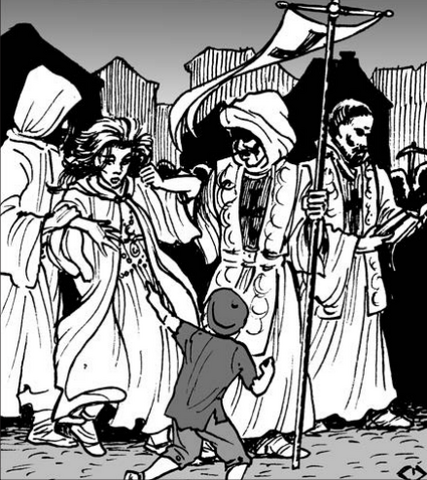
The Servants of Hecate: Taking their name from a smear campaign against female Initiates used by the Medieval Roman Lodge, the Servants of Hecate are a matriarchal Lodge that was founded by priestesses of various fertility deities, Initiate nuns, and Henry II's wife Eleanor of Aquitaine. The Lodge had an uneasy peace with the other Lodges until one of its members, Joan of Arc, took part in the Hundred Years' War. This gave the other Lodges an excuse to brand Servants of Hecate as heretics corrupted by the demiurges, and a non-small number of its Lodge members were tortured and murdered over the course of the Inquisitions. Ever since then, the Servants of Hecate have been mistrustful of the classical Lodges, and have found more common ground with the Voodoo Initiates and other native magical groups than their supposed brethren. The group is even behind the rise of Wicca, neopaganism, and feminism, spitting right in the face of the Roman Lodge.
The Hermetic Order of the Golden Dawn: The Golden Dawn is a Lodge that was born in Egypt during the waning decades of the Roman Empire. These guys are basically another flavor of the Enlightened, even having fingers in the same Freemason and fraternity pies, and are big fans of white British people. Members are the Golden Dawn are typically selected for being rich and intelligent on top of having magical talent. The typical jobs Golden Dawn Initiates get up to are either investigating Corruptor activity or keeping mundane society in the dark about the supernatural by funding professional debunkers and skeptic organizations.
The Ophites: One of the stranger minor Lodges, the Ophites hold that the serpent of the Garden of Eden is actually the protagonist of the Bible, being the one who was able to free humanity's mind from the grips of the demiurges. They see both this serpent and other snake deities the world over as evidence of the spritual path of knowledge and asceticism that has been set forth for humanity. The Ophites are also the only Lodge with non-human membership (that's admitted to, at least), with a number of its Initiates in the past several centuries being the serpentine In-Betweeners known as the Snake People. Why these particular Snake People are both nonviolent and open to Initiation is a mystery to everyone besides the Ophites.
The Readers of the Kabbalah: A Jewish lodge that follows the Torah and Jewish mysticist traditions. They were originally almost entirely concerned with the spiritual world rather than material one and kept to themselves, but other Lodges jealous of their talents kept instigating antisemitism and spreading conspiracies about Jewish overlords in order to keep the Kabbalists down. This, of course, spilled over in World War II, when the Kabbalists took up arms against Nazis and Nazi-fueled Corruptors. Ever since then, the Kabbalists have distanced themselves with the European Lodges and ramped up their fight against the Corruptors. Some particular Kabbalist councils, the Israeli Lodges, also have been engaging in conflict with the Islamic Lodges for the past half a century.
The Islamic Lodges...don't get their own entry, actually. All we know about them is that Lodges are split along the Sunni-Shia divide, that Sufi mystics in particular make great Initiates, and that they've been having conflicts with the Readers of the Kabbalah. That's it.
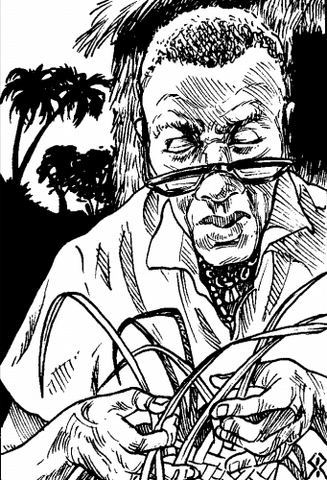
The Schismatics
Various horrors from the 20th Century onward, especially that whole "the German Lodges went crazy and helped along the Holocaust as part of a massive human sacrifice ritual to the Corruptors" incident, have led to repeated breakoff groups that went to make their own less bigoted Lodges (and since Aleister Crowley was involved with one of them, they may have in fact been with blackjack and hookers). This especially blew up in the 1960s, as more and more Initiates realized that being a racist white man was not necessarily the best course for changing history. Collectively, the Lodges that split off in the 20th Century are known as the Schismatics. These do not technically include the Servants of Hecate or Readers of the Kabbalah, even though those Lodges hem far closer to the Schismatics than the traditionalists. Two specific Schismatic Lodges are given some air time in the book:
The Crowley Society: The Great Beast/Master Therion/Aleister Crowley created this Lodge as a schism from the Hermetic Order of the Golden Dawn. The Crowley Society's members follow the vision of the Carpocratian sect of Gnosticism, which states that gnosis lies in complete and total experience of the breadth of material vice rather than eschewing oneself from it. They love to engage in BDSM, have kinky sex while letting spirits possess them, have sex with In-Betweeners, and take designer drugs. In spite of other Lodges pointing at them as the biggest evidence of Corruptors influencing the Schismatics, Crowley Society Initiates constantly bumble into heroism, stopping various evils in order to keep the party of life going rather than out of any altruistic goal.
The Wild Hunt: Riding forth under the mantle of the horned god Cernunnos, the Wild Hunt is made up of fanatical hunters of Corruptors, corrupted Initiates, and In-Betweeners. Most, but not all, members are those who had spontaneous Initiation from horrible events and have internalized that pain as a righteous fury. They don't have any fear of death or suffering, but also have no compassion for those they fight, and all the other Lodges are a bit frightened of the Hunt's ruthless dedication to their cause. A Wild Hunt ride typically consists of a few Initiates investigating their target before calling in the reinforcements, which include both warrior Initiates and brutal hound spirits.
Next Time: The
"The world is steadily plunging toward chaos"
Original SA post
Part 3: "The world is steadily plunging toward chaos"
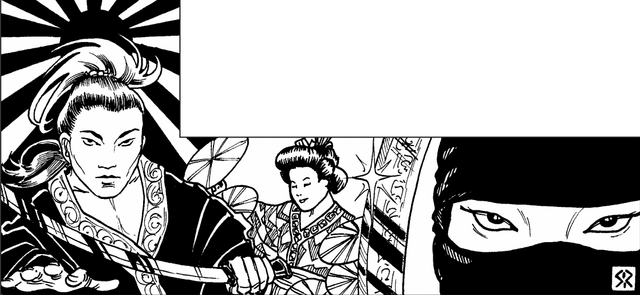
This picture seems so out of place in this book.
Who's in Control?
While much about the Lodges and Voodoo societies is set in stone, there are some brief words on real world organizations and institutions that are much more fluid. Rather than one definitive statement about them, you get several footnotes on what may be going on and have free reign to pick and choose which, if any, are true. More than one might even be true, becoming just as winding, twisted, and potentially contradictory as real world conspiracy theories. For instances, the American military might be a joint project of the Roman and Enlightened Lodges who snuff out rival initiates during wartime and conduct dark magic rituals in the Pentagon, or it could straight-up be crawling with Corruptors influencing its actions. These tiny snippets are ideas are given for the branches of the US government, the FBI, the US military, the US court system, the Mafia, and Japan.
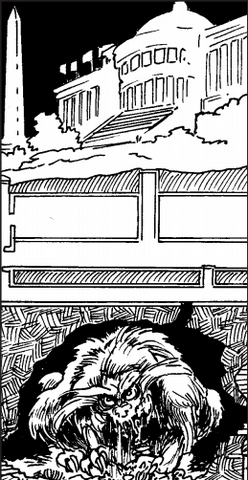
The Corruptors
Broadly speaking, any spirit that is actively malevolent towards the human species, rather than either benevolent or indifferent, is referred to as a Corruptor. Some say that the Corruptors first drifted from the spirit world when humanity evolved in Africa and have been haunting us ever since, while others feel this is too humanocentric and the truth is that Corruptors are primordial gods from the dawn of time that have dark goals far more vast and inscrutable than the human mind can comprehend. Whatever the truth, it's an undeniable fact that the Corruptors love it when people are being bad. Rather than being the root cause of darkness in the human heart, however, they simply latch onto our innate capacity for evil and poke it with a stick long enough that atrocities come out.
The Corruptors worked all sides of the slave trade, both guiding their cultists to work with the Dahomey and Yoruba practices of enslaving rival groups in wartime, coaxed slave owners into performing heinous acts in exchange for occult power, and offered Initiate slaves broken by anguish a chance to escape their torment through the old deal with the devil gambit. In the Cold War Americas, they lived it up through political unrest in the Caribbean and Latin America, including lending their talents to Papa Doc Duvalier and Fidel Castro. And then there's the drugs...
quote:
In a way, drugs have been a big business in the Caribbean for centuries. Addictive luxuries like tobacco, coffee, white sugar and alcohol have been among the main staples of Caribbean agriculture. Some occultists believe the Mayombe enjoyed the bitter irony of this – using slave labor to produce substances that would in turn enslave those who used them.
The big question is...why? Nobody's sure. The only idea anyone seems to have is that, maybe, Corruptors can become material entities if they get enough bad vibes collected up, at which point they can directly and physically cause suffering rather than use proxies. The only ones who are capable of stopping whatever their plan is are the Initiates. Unfortunately, most traditionalist Voodoo practitioners and Lodges aren't too keen on getting into the Shadow War, dealing with problems as they crop up rather than directly trying to stop the Corruptors at the root of it all. It's almost certainly up to the new generation of Initiates from both Western and Voodoo backgrounds who are willing to put aside their differences and act as one unified front against the Corruptors to
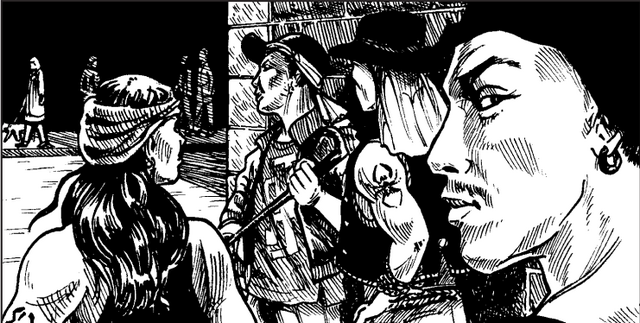
The Red Sects
As with "Corruptor", the term "Red Sect" is not a self-identifying one, but instead a term used to classify any and all groups that serve the Corruptors. Be it for money, power, fame, or just to be a tremendous asshole, there are indeed people who seek out the dark spirits and commune with them. As with the Voodoo sects and Lodges, specific Red Sects and Red Sect archetypes are laid out in the section.
Bokkor: Whether you call them bokkor, bokor, mayombero, or palo mayombe, these guys are bad news. They are hired to use Voodoo powers to inflict suffering on others, usually in the form of killing them outright, but also tend to desire to corrupt their clients into being part of the Corruptors' sphere of influence as well. Bokkor are heavily tied to In-Betweeners as well, often either allying themselves with monsters or using ancient dark rituals to become monsters themselves. It's stated that Bokkor are actually quite common in the Caribbean and Latin America already, and are swiftly becoming more and more a fixture in the inner cities of the USA.
In-Betweeners: As stated before, In-Betweeners get their name from being a form of life that bridges the gap between material being and spirit. Most In-Betweeners can mask themselves as everyday human beings, some of them even gaining influence as crime lords, celebrities, and politicians. For the most part, In-Betweeners are creatures of base desires, innately burdened with traits such as excessive lust, bloodlust, sadism, taste for flesh, or even a compulsive need to murder. A vast majority of In-Betweeners are servants of the Corruptors, which some blame on the fact that they only have half a soul (this also prevents them from having an afterlife or becoming full spirits). There are some Initiates that even go so far as to say to that even the most benevolent In-Betweener is incapable of freeing itself from the cycle of materialism and will inevitably fall into the clutches of evil. These people are what we in the business call 'completely fucking wrong', as there are In-Betweeners fighting the good fight such as the Snake Men of the Ophite Lodge.
Secret Societies: The Corruptors' servants have their own equivalents of bizongues and Lodges. They have no one name for these societies, though those that specifically pretend to be Lodges in order to draw in Western Initiates are collectively known as the Dark Lodges. Members of a Corruptor secret society are fanatics with an undying loyalty to their patron spirit, carrying out human sacrifices and any other number of heinous acts in the name of their dark gods.
Drug Lords: Most drug lords aren't Initiates, nor do they serve the Corruptors knowingly, but instead act as an unwitting extension of their will. Instead, intermediaries such as Bokkor and In-Betweeners often put themselvs in a high position in a drug lord's organization to influence them directly. Of course, there are in fact some drug lords that are themselves In-Betweeners or Initiates, so you have those as well. There are also some drug lords in the former category that nonetheless tie themselves in with the supernatural by conducting human sacrifices or praying for divine boons from patron spirits (while not named in the sentences on that matter, I'd imagine Mexico's Narco Saints were in Carella's mind when writing that). Oh, and there are some magical drugs in the trade, including one that lets a Corruptor possess someone and taint their mind and soul.
Slavery: As with drug lords, slavers and pimps aren't directly Corruptor servants, but achieve the same effect anyway. Prostitutes give Corruptors the same warm and fuzzy feeling slaves do, as they are stated to both effectively be the same thing. Child slavery rings that sell to pedophiles are, of course, mentioned prominently because this is the 90s and we need to sharpen The Edge.
Politicians: This is the origin of that quote I put in the introduction about Corruptors loving conservatives and revolutionaries, radical feminists and misogynists, and fundamentalist religious individuals and secular humanists alike, because something something Horseshoe Theory but with magic. Besides those groups, Red Sects love repressive lawmakers who violate civil rights, those that perpetuate of the War on Drugs, and the ones who make it easier to fill the prison system. Politicians who aren't in the pocket of the Corruptors are in the pocket of one of the Lodges or bizongues (vastly more the former than the latter of those two), because nobody gets anywhere politically these days without Initiate influence.
The Police The book assuringly pats us on the back and tells us that most cops are "dedicated people trying to do a dangerous, difficult job despite being overworked, underpaid, and destructed, feared, and looked down on by the very people they swear to protect". All those stressful things and lack of public trust makes some cops get frustrated and view the world in an us-vs-them mentality, however, which the Corruptors exploit. Some cases of police brutality are actually dark rituals or staged to make the public more distrustful of the police, with the ultimate goal being an all out orgy of violence between the police and the public. It's stated the the LA Riots were "a dress rehearsal" for this ultimate Corruptor plan.
Cults: Most cults are just money schemes or idealistic religious groups, but some of the dark and crazy ones actually draw the attention of the Corruptors. It's stated that even some natural disasters (though, oddly enough, it's not stated which one) were actually occult rituals gone wrong.
Serial Killers: Not only are there thousands of serial killers on just the North American continent alone, much less the rest of the world, most of them are Initiates who use their magical talents to keep from being caught. They love torture and human sacrifice, worship the worst of the worst of the Corruptors, and a number of them are in an organized serial killer's guild called the Murder Society. The Murder Society has contacts within every political and law enforcement institution that allows them to further cover up their activities. And as if all of that wasn't enough, it gets laid on extra thick with there being a slave trade that gives the Murder Society people to play The Most Dangerous Game with on Society-owned "killing farms".
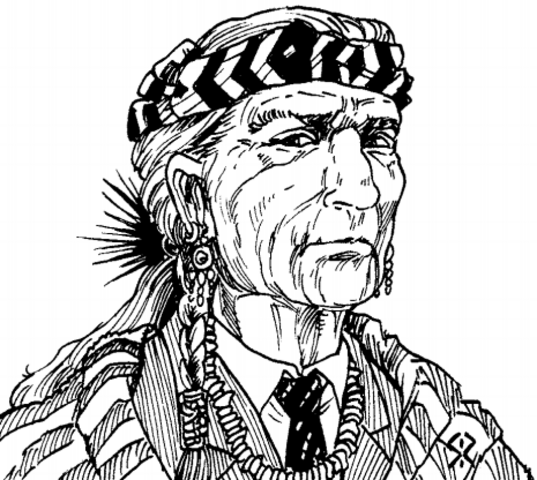
The Others
AKA "these guys matter I guess, but we didn't have the book space to care more about them", this is the section where all the other Initiates get plopped down, most in such tiny detail that isn't really enough to warrant individual paragraphs in the review as the bizongues, Lodges, and Red Sects did, but I'll at least give them a bullet list to avoid clutter.
- Native American shamans fight Corruptors and Lodges to protect their ancestral land, and are typically on pretty good terms with the Voodoo groups.
- Rune mages were once part of the German Lodges, but quickly went into hiding after World War II due to their support of the Nazi regime. They use runes.
- While a lot of Celtic and Germanic Initiates of the old European religions got shoved into the Servants of Hecate to avoid being horribly killed, there are enough still hanging around that they've gotten into the business of helping along Wicca and other neopagan movements.
- 'Rappy,' you ask me, 'are there magical Roma here?' My answer: it's a 90s occult conspiracy roleplaying game, no shit there's magical Roma. The Nazis actually targeted the Roma to destroy their magical traditions as Lodges are wont to do, and their status as "the most powerful independent mystics of Europe" has let them survive persecution time and again.
- The African nations have a mix of traditional religious believers and Muslim mystics on the unaffiliated Initiate front. They're suffering a lot from the Lodges, however, as well as the Corruptors that work to keep Africa a hotbed of suffering.
- While imperialism let the Lodges keep a firm grip on the Asian continent for a while, "that continent's magical knowledge is vast and ancient", so they won out. Triads, tongs, and yakuza typically have Initiates backing them up, and Asian Corruptors followed immigrants to the American West Coast where they keep doing what Corruptors do.
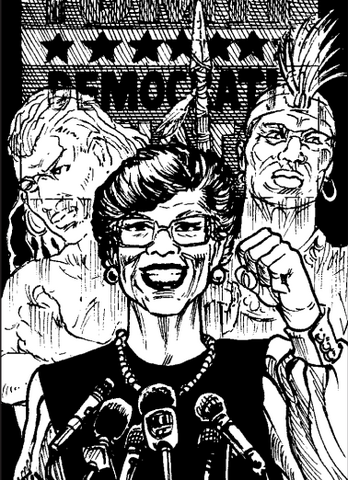
New Cambridge: A City of the Shadow War
As the final piece of chapter 1, we get a fictional city in an unspecific part of the US East Coast as an example of the setting in use. New Cambridge has been around since the 1700s, but much of it has fallen into poverty, urban decay, gang violence, and drug trafficking in the past couple of decades. The city's poor regions are mostly black and Hispanic, nobody wants the police around even though they don't want to go anyway, and ten santero Initiates are the people locals usually call on when there's a problem. There are also four Loa Lords and the ghost of their fallen comrade that fight drugs and a very powerful Corruptor, three Initiates of the Lucumi that work with the local NAACP, twelve Golden Dawn Lodge Initiates, eight Roman Lodge Initiates, four Enlightened Lodge Initiates, and six Schismatics and Servants of Hecate/Ophite Lodge Initiates that make up the wizarding population of the city.
The true ruler of the roost in New Cambridge, however, is a Devourer (the most powerful type of Corruptor, basically summed up as Great Old Ones) that has corrupted one of the multiple Lodge members on the city council. Its servants are several lesser Corruptors, In-Betweeners that resemble ragged-clothed men with metal blades instead of fingers that have become part of the city's urban legends, and an insane Native American Initiate who lives in the sewers and kidnaps people to sacrifice to the Devourer. A few other Corruptor spirits operate in the area via local drug lords and two Snake People. The ultimate plan of the Devourer for the moment is to have a police officer murder a black child in cold blood and then have a race war start as a result. The Lucumi and Lodges are too at each others' throats to stop this, so it's up to the young blood Loa Lords and Schismatics (that's you, prospective player!) to get the job done.
Next Time: A hobo, a magic child, and a prostitute walk into an adventuring party...
"Whoopi Goldberg's character in the movie Ghost is a good example"
Original SA post
Part 4: "Whoopi Goldberg's character in the movie Ghost is a good example"
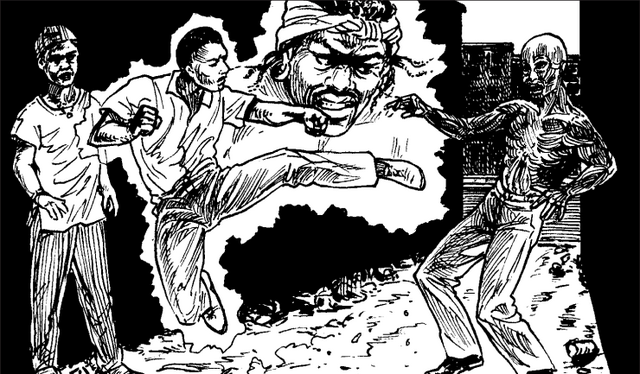
Chapter 2: Characters
As with chapter 1, chapter 2 and all future chapters have a page or so of introductory fiction. We’ll be skipping over those unless there’s something particularly amusing in them, which there isn’t in this case. This is our chapter for actual game rules, so the summarizing will be more concise and we won’t be having three posts to get through the meat of a chapter. It is here that we get the label "heroic dark fantasy" for the setting, an interesting choice given that this is around the time that the term urban fantasy started getting some real running legs. We also get to see the wide scope of power levels you can play as. These are 100 points (you're just some slightly above-average schmuck, usually having just learned of the Shadow War), 150 to 200 points (First to Third Level Initiates; more on levels of Initiation in a bit), 250 to 300 points (Fourth and Fifth Level Initiates, as well as lower tier ghosts and In-Betweeners), and 400 to 500 points (powerful magicians and playable supernatural beings).
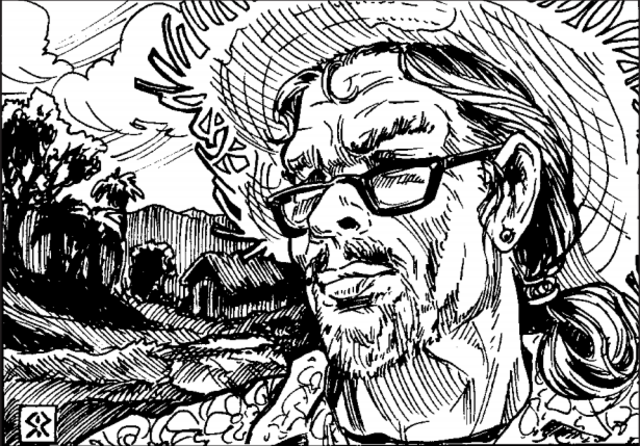
Character Types
Created a few years before GURPS started using the concept of occupation templates to expedite character creation, GURPS Voodoo’s segment on character archetypes are a general suggestion on why that type of character would get involved with the Shadow War coupled with a smattering of suggested traits and skills. Since most of these are pretty self-explanatory, I won’t spend much time on any particular one.
- Artist: Whether the starving artist stereotype or someone with a patron, it turns out that some artists are just so artsy because they are undiscovered Initiates unconsciously tapping into the spirit world.
- Charlatan: The con artist who wants people to believe they have supernatural powers, even though they almost never do. This is where the Whoopi Goldberg namedrop from above gets made.
- Cop:Law enforcement officials are stated to have a bit of a step up when they get pulled into the Shadow War due to their weapon skills (spoilers: this isn't true, as we'll later learn about the near-immunity to bullets In-Betweeners have). We also get told that while police in third world countries are sometimes oppressors – no idea why there's the sudden caveat of it being a third world thing – most of them are still "dedicated professions who have to deal with political bosses, abusive foreign tourists that they must not offend, and a populace that distrusts them".
- Cultist: What we heard about these guys back in chapter 1 gets repeated again. There's also the new tidbit that certain Corruptors pretend to be European demonological entities to trick Satanists into being their pawns.
- Drug Dealer: As the evils of addiction are all spurred on by the Corruptors, an ex-drug dealer character is said to be an especially good spy against them,
- Expatriate: This character's an American or European expatriate to the Caribbean. They are either a Caribbeaboo who has "gone native", a mystery person with a tragic shadowy past, a comic relief character, or just some asshole.
- Gang Member: Same deal as drug dealers.
- "Gifted" Child: An abused or traumatized child that has awakened to Initiate powers but almost always having below-average mental and physical attributes: the character everyone wants to play!. Some of these kids are actually their past lives reawakened through whatever caused their Initiation, leading to an adult from another age having to deal with being in a child's body. Beware playing a child in general, however, as "like a slave, a child has to learn to manipulate the situation to his advantage; unable to escape the control of adults, he has to outwit them".
Homeless: Many homeless people get the traumatic spontaneous Initiation treatment. There are also "modern-day hermit" characters who have become ascetics by voluntarily living on the streets, as well as those taken in and Initiated by the Loa Lords or Protectors since those are the cool kids' bizongues.
- Journalist: The sharp-eyed and sharp-tongued reporter with a nose for the truth has come straight out of the pulps and into the streets of GURPS Voodoo. Turns out that tabloids have more truth than you’d think, as they’re often the only ones willing to print stories straight from the front lines of the Shadow War.
- Magician: Surprise, "many if not most" stage magicians are actually Initiates! They make good agents as they can pass off their supernatural bullshit as sleight of hand, and the Lodge in particular has attained a fondness of using stage magician Initiates become professional skeptics to work as disinformation agents. Bet you never knew that about the Amazing Randi.
- Houngan/Mambo: Your basic Voodoo Initiate. You know, the ones we went over a fair bit in chapter 1. Moving on.
- Medium/New Ager: While not as numerous as stage magician Initiates, there are some spiritualist mediums and New Age mystics who know true magic. The New Agers, unfortunately, often have their "rosy view" of spirits and the great beyond "brutally shattered by their first encounter with a Corruptor, or, worse, an In-Betweener monster!"
- Parapsychologist: This title is probably the only time parapsychologists will ever be called not open-minded enough. They want unreasonable things like scientific explanations and tests of supernatural abilities in controlled environments, when gods and ghosts work in mysterious ways and aren't so easily pinned down. Some of them are secretly used as disinformation agents by the Lodges (those guys sure do love a good disinformation campaign), while others are actually unaware spontaneous Initiates whose skepticism shapes their magic in such a way that they ward off supernatural forces through sheer disbelief.
- Priest: Ones of the Abrahamic sort, specifically. After a warning that "Initiate Christian priests are a possibility, but may be controversial in some gaming groups", we’re nonetheless reminded that the Roman Lodge canonically has a stranglehold on every denomination of Christianity already.
- Prostitute: If you're looking for a nuanced take on sex workers, you'll probably need to look somewhere other than a 90s RPG whose entry here uses the phrases "ideal victims" and "good looks don't last long in the Life".. Prostitutes are enslaved and abused, caught young and die young from STDs, drugs, violence, or being a popular target for human sacrifice or In-Betweener foodstuffs. Some manage to have traumatic spontaneous Initiation and get magic powers, though. Hooray!
- Refugee: Due to the setting's focus on the Caribbean, USA, and Latin America, Cubans fleeing the Castro regime and Haitian boat people are given top billing in this segment. They're often abused minimum wage workers, some of whom are Initiates, and that's about all there is to note here.
- Scientist/Professor: Academics often get caught up in the Shadow War by poking their nose into the wrong cultural studies, messing with the wrong quantum dealybobbies and tapping into the spirit world, or digging up some artifact of ancient evil. As with the parapsychologist, we are told that attempts to explain anything won't actually defend you against the supernatural, so eat it nerds.
- Witch/Shaman: Any religious Initiate that isn't Voodoo or Abrahamic. We're told that "more information on those magical traditions will be provided in future supplements". Well...sorry about that, Mr. Carella.
- Singer/Performer: Musical performers who are Initiates are like modern day D&D Bards, wandering around doing magic adventures while on tour. Rap and reggae performers in particular are often privy to the Shadow War.
- Soldier: Nearly all the world's militaries are at least partly influenced by the Lodges, usually the Enlightened Lodge, and some traumatic spontaneous Initiates crop up in the ranks.
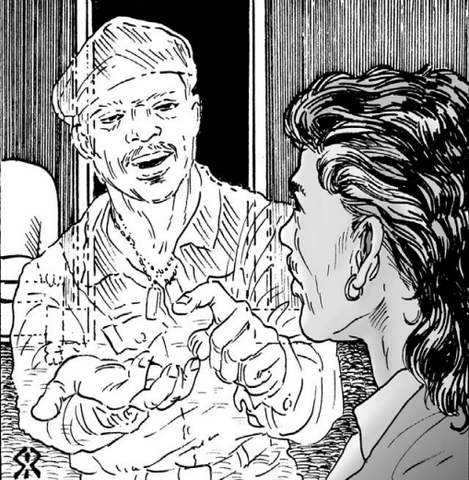
Advantages
Five new advantages for GURPS Third Edition are presented in this section, some of which even made their way into the next edition. Ghost means you are an incorporeal spirit that has to play by the rules laid out for ghosts in a later chapter, Initiation is briefly stated to exist here but gets its own section in this very same chapter, Karmic Ties gives you a positive or negative link that continues on from a past life (two lovers inseparable even by reincarnation, eternal enemies, etc.), Rank (Lodges) is your degree in a Lodge, and Reawakened means you had your memories from a previous life wake back up. I should also note that it's here we learn the names of the different degrees the Lodges have, and bottom tier members are called either Mundane, Layman, or Ignoramus. Good to see that the Lodges have the sensibility of an elementary school student.
Disadvantages
Only one thing added here, and it’s Voices. You hear shit in your head, be it hallucinatory or very real spiritual presence. This disadvantage has the rather odd note that electroshock therapy might in fact drive away spirits.
Skills
Turns out that GURPS Voodoo was apparently the origin of the infamous Erotic Art skill GURPS has. Huh. You learn something new every day. There are also three explicitly supernatural new skills provided as well. Ritual Magic is the skill you roll to make magic do magic things, Vever Drawing lets you create a traditional Voodoo ritual icon to beef up your magic (knowing Ritual Magic already lets you do Vever Drawing at a -4 penalty without paying for the separate skill), and Shapeshifting lets you...well...shapeshift.
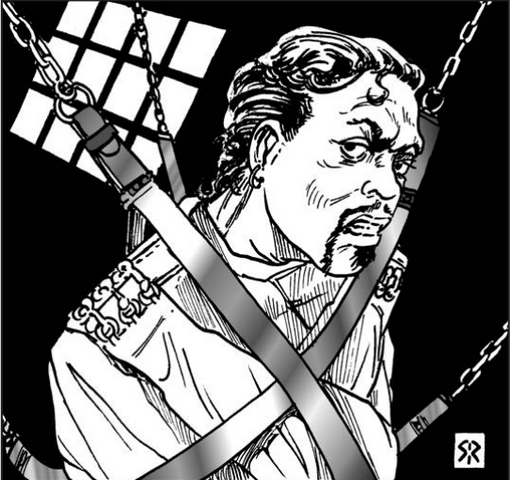
Initiation
Initiation is a deep enough advantage that it gets its own whole section of the chapter. Not only is it the advantage that holds the power of magic, it also irrevocably changes the life of the Initiate.
Levels of Initiation go from First to Tenth, and we even get statistics on around how many post-First Level Initiates exist in the 1995 world population. There are 666,666 Second Levels, 200,000 Third Levels, 100,000 Fourth Levels, 50,000 Fifth Levels, 10,000 Sixth Levels, 1,000 Seventh Levels, 500 Eighth Levels, "None? 20? Who knows?" Ninth Levels, and "Who knows?" Tenth Levels. I don’t actually mind this too much, as it is just some oddly specific flavor and isn’t used as a bludgeon against the players. Carella even notes that the whole like-attracts-like rule for Initiation means that a whole adventuring party of Initiates is the most likely scenario to happen. Of course, this still leaves the question of what different Levels even mean. Lucky for you, there’s no wait to find out.
A First Level Initiate has access to Ritual Magic, obviously, and also gets a Spidey Sense towards the supernatural that manifests as a tingle, “gut feeling”, etc. They can also learn how to channel their powers into self-induced trances or being better at tasks through preparatory visualization of performing the task. Second Level Initiates get a stronger spiritual aura that causes individuals with the same spiritual beliefs to be attracted to them and individuals who are atheistic, members of an antagonistic belief system to yours, or have "fragile egos" have a distaste of you. This is also when you can learn how to channel spirits, so genuine mediums are at least Second Level. Other special abilities a Second Level Initiate can learn are Mystic Symbol, which lets the Initiate channel magic and resist supernatural forces better when they are holding a holy symbol of their belief system, and Spirit Advisor, which lets the Initiate have a non-combatant spirit that can be consulted on various matters. Moving up yet again, Third Level Initiates no longer have to make an IQ roll to get their sixth sense going and are able to communicate with and command spirits without needing a mystical conduit to do so. They can also optionally learn to put themselves into a state of torpor or buy a minor combat-capable spirit buddy.
Moving further up the ladder, Fourth Level Initiates can always see and hear spirits, even if they might not be in the mood for it at the time, and if not properly cautious may be misdiagnosed as schizophrenic and locked away in an insane asylum. Whoops! The biggest thing about getting to Fourth Level, however, is the ability to buy the advantage Spirit Warrior. Gods and spirits, including the loa, are known to "ride" hosts (known as Horses or Mounts during the riding) via possession. If you have Spirit Warrior, however, you are both able to exert your will enough to stay mostly yourself as a Horse and channel some of the riding spirit's powers that don't get transmitted to just any old person they possess.
After Fourth Level, things start changing somewhat less drastically each time for a bit. Fifth Level Initiates are instinctively drawn to situations that offer them an opportunity to use their powers in a way that both challenges and rewards them and can optionally gain the powers of faith healing or astral projection, Sixth Level Initiates can optionally buy the ability to no longer age, Seventh Level Initiates get a bunch of spirit hangers on as an innate rather than optionally-bought trait, and Eighth Level Initiates can now just make a Will vs. Will contest to damage spirits through sheer force of personality, permanently killing spirits that are dealt with in this manner. This, of course, only leaves the two big top tiers left.
A Ninth Level Initiate has more or less become a force of nature unto themselves. They have to make a Will save at -6 to not reflexively hex someone who has offended them or bless someone that has pleased them, non-Initiate humans are at a -6 to all attack and defense rolls against them, and all but the strongest hostile spirits flee from their presence. Finally, upon reaching Tenth Level, the Initiate effectively becomes a racial template unto themselves. They have Charisma 6, Strong Will 5, and a number of spirit allies equall to their IQ stat times two. Mere uninitiated humans have to make a Will roll at -5 to even think about hurting the Initiate, and even if they succeed only critical hits do damage. The only thing that is a true threat to a Tenth Level Initiate is a supernatural being or another Initiate. As a big hook for your big heroes to do big things, it’s suggested that of the unknown number of these centuries- or even millennia-old superbeings, at least one is a Corruptor servant, and that Tenth Level Initiate in particular may be the Jenga block that breaks the tower of evil if pulled out of the equation.
Sample Characters
In the final segment of chapter 2, there are three sample characters, each from a differing power level of the campaign.
Sheila Brown, Initiate of the Servants of Hecate (100 Points): Sheila Brown, Second Level Initiate of the Servants of Hecate, was Initiated into the Servants of Hecate by her aunt Ingrid after Sheila's lawyer father got their family nearly killed by unwittingly thwarting the plans of a corrupted Lodge Initiate and getting a load of curses cast on them. After she and Ingrid counterspelled the corrupted Lodgeman to death, she left her family behind and became a full time member of her aunt's Lodge. Perhaps unsurprisingly given that background, Sheila's magic spells are almost entirely focused on protection, healing, and luck manipulation. Nothing else really stands out about her, though, being an Attractive-advantaged young woman with archetypical Irish features, below-average Strength, and a high IQ score.
Joshua Carson, Spirit Warrior (300 Points): Joshua's a Fourth Level Initiate of the Loa Lords who is a gentle giant in his mid 20s who got his powers at the young age of 13. Back then, he was tortured by a gang, during which the loa Ogun came down to him and offered to save his life in exchange for a lifetime of serving Ogun as a bare-fisted shit-kicker against evil. Unsurprisingly, he took the offer. Joshua has no magic rituals whatsoever, instead using his Spirit Warrior powers and direct tie to Ogun to Hulk out and fist fight his way through drug dealers and In-Betweeners.
Orion, Wild Hunt Initiate (450 Points): Born Arthur Hawthorn, this former yuppie and son of a prominent Enlightened Lodge member was traumatized by seeing firsthand the results of human sacrifice to an In-Betweener. Now he's a Wild Hunt member in biker leathers who mercilessly uses his powers of spirit magic and projection-based possession to puppeteer those he sees as deserving targets into being pawns in his war against the Corruptors. He's also a Spirit Warrior like Joshua, calling upon his personal genius (that's genius as in the Greek name for spirits of places and things) to further augment his physical prowess.
Next Time: Yer a Ritual Wizard, Harry.
"Ironically, most practitioners of either Voodoo or Lodge magic will be quick to deride the other style as inferior, and will bristle at the idea that, essentially, they are doing the same thing by different names!"
Original SA post
Part 5: "Ironically, most practitioners of either Voodoo or Lodge magic will be quick to deride the other style as inferior, and will bristle at the idea that, essentially, they are doing the same thing by different names!"
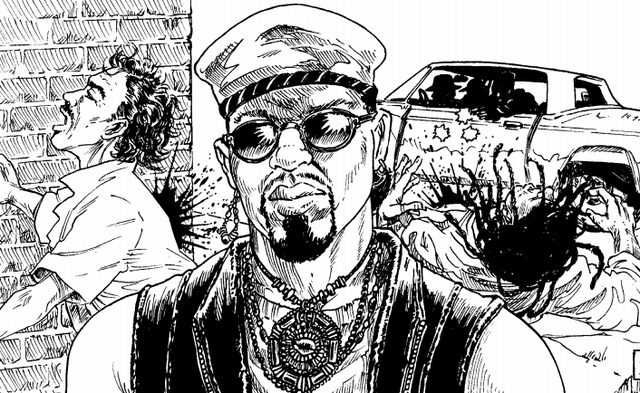
Chapter 3: Magic
As a universal gaming system that has existed for multiple decades, there’s not really anything suprising about the fact that GURPS has had various different magic systems over its lifespan, from the core GURPS magic system wherein you buy each spell as its own skill with its own skill ranks to roll by to the recent sorcery system that fully transfers spells into an advantage-based system. GURPS Voodoo uses what it calls ritual magic, which would act as the progenitor of the Ritual Path Magic system that is one of the most popular in GURPS Fourth Edition. Ritual magic is subtle but powerful, relying on going through the motions to invoke a specific end result rather than casting Magic Missile at your problems. You make your preparations, call the spirits, give them your request, make your offering, and hope for the best.
The skill system for ritual magic consists of three tiers: the Ritual Magic skill itself, a skill for each of the five types of magic (known as Paths), and a skill for each ritual within the Path. Each of these tiers requires the previous one, but not vice versa; for instance, you can cast a ritual via its Path skill or Ritual Magic for a modest penalty, while you can’t put skill points in the ritual at all if you haven’t already put at least one point into Ritual Magic and its Path skill first. This means that you can have a character with points calculated down to every ritual they want to perform with little chance of failure, or you could go the opposite way and have someone who has a bunch of points put into just Ritual Magic so that they’re a magical jack of all trades but master of none. As it’s a system where magic is produced by asking favors of the spirits, you can even have a non-Initiate who knows the general practices of the sacred ceremonies cast a spell...at a hefty penalty to their skill roll, of course.
Rituals also have three "elements" tied to them that affect their skill rolls as well. The Element of Time dictates that rituals typically have a preparation period of ten minutes to an hour, wherein dancing, chanting, playing of musical instruments, or other ceremonial gestures are performed. A caster in a hurry can take a hit to their skill roll to skip the performance, while one with a lot of time on their hands can repeat the ritual for several days in order to keep boosting their roll. The Element of Consecrated Ground dictates that spells are harder to cast when not on hallowed soil. Temples and sacred sites that have had magical rituals conducted in them continuously for twenty years or more have become consecrated; if you aren't in one of these places, you either eat the penalty or take a few minutes to temporarily consecrate your location by placing candles, symbols, and arcane etchings around you.
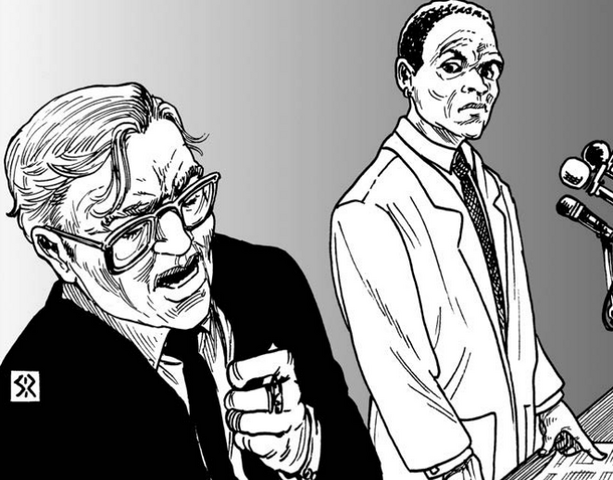
Finally, there's the Element of Material Components, which reflects offerings to the spirits as well as what is known as the Law of Contagion. The former is pretty self-explanatory, as you give the spirits something they like such as rum, cigars, a sacrificed chicken, or whatever. The latter is the concept that your magic is more powerful if you have created a link to the target (this link being the titular contagion): an effigy of the target is nice, a photograph's even better, and a DNA sample such as hair or blood gives the spirit you're invoking plenty to work on. There are also certain symbols that work particularly well with specific rituals and spirits. For example, the traditional asson rattle pleases the coupled loas Damballa and Ayida-Wedo, while Ogun loves images of himself engraved on a nice metal blade. There are also negative modifiers for the more people a ritual is meant to target and positive ones for multiple individuals working toward the same ritual, but ultimately those are less interesting topics for a review and will only get this sentence.
Closing out the magic chapter are the Paths and the rituals themselves. The Path of Dreams allows for both the astral travel to the world of dreams and the ability to manipulate the dreams of others, the Path of Health is the two-way street of both healing and harming others, the Path of Luck covers blessings and curses, the Path of Protection helps ward against both physical and spiritual threats, and the Path of Spirits deals with influencing both entities of the spirit world and souls of the living. Initiates of all creeds and backgrounds draw on these same five forces, though some rituals are called different names by different groups even though they are ultimately the same thing. An example for this would be the ritual for sanctifying a home against intruding spirits, which Voudonistas call Sanctuary and the Lodges call Aegis.
As for actual rituals, there aren’t a massive amount, presumably due to page count restrictions: five each for the Path of Dreams, Path of Health, and Path of Protection, eight for the Path of Luck, and eleven for the Path of the Spirit. You also get a paragraph on making your own rituals that can be summed up as "I dunno, just make stuff up I guess, just remember to have the three elements and a skill penalty if it's particularly hard to do". A few of the rituals presented include...
- Succor, which lets you slap some herbs and sugar on a wound and have it work as well as actual proper first aid.
- Evil Eye has you call on spirits to let you cause someone to have a heart attack, stroke, or kidney failure with a glance. If you fuck the ritual up too badly, though, the spirits will target you for the attack instead.
- Journeyman’s Course makes the target suffer an injury or loss of pay at their job. As spirits are often fickle assholes, this ritual affects both the target and the caster if it fails badly enough.
- Ghost Shirt, known to the Lodges are Achilles' Shield, creates a probability bubble that makes projectiles less likely to hit you. It's stated that members of the Boxer Rebellion and the Ghost Dance tradition – yep, it's the 90s alright – made use of this ritual.
- Raise Zombie lets you create a zombie of the actual Haitian lore sort, not the walking dead sort. After poisoning the victim with ritually-prepared powder made of various unsavory materials such as the tetrodotoxin of a pufferfish, they go into a death-like state that is almost impossible to discern from actual death. When you go and dig them up after the funeral, they seemingly miraculously come back to life, though now as a brainwashed slave with near-immunity to pain.
Next Time: After this shorter update, the next one’s going to bury you with its size. It’s time for a spectral spectacular.
"The Mount will either behave like a young seductress, an old wise woman, or a nagging hag"
Original SA post
Part 6: "The Mount will either behave like a young seductress, an old wise woman, or a nagging hag"
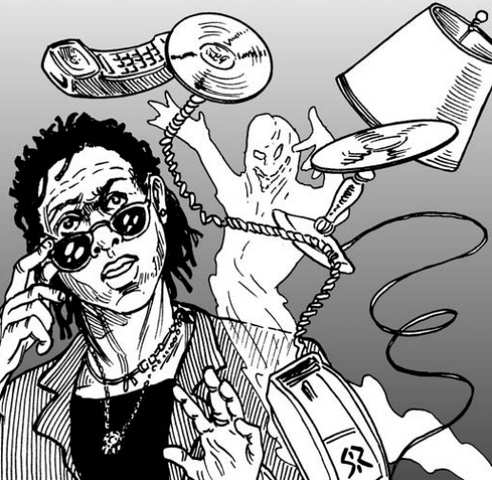
Chapter 4: Entities
After talking up spirits for a while, we now get the chapter that actually lays out more about them. First, what’s up with a soul? You have two of them, actually. The essential soul is the spark of life that animates the body and goes through the cycle of reincarnation, while the individual soul is the thing that gives you personality, opinions, and memory. Spirits are psychic manifestations made up purely of an individual soul, having no essential soul whatsoever, and are either a willful entity sprung from the world of spirits or the lingering essence of someone whose essential soul has already passed back into the cycle of life, death, and rebirth.
Second, what can a spirit do? All spirits have a sense of sight, smell, hearing, and a bit of taste if they're ritually offered food or drink, but need to solidify themselves into a materialized form to have touch. They can also sense human emotions and supernatural powers/beings, as well as hear their names spoken anywhere in the world whenever someone invokes them during strong emotions or some manner of ritual. Being incorporeal beings, spirits don't have to follow human laws of motion, being able to float, move through solid objects that aren't warded, and teleport to either certain places directly tied to them (such as a grave or place of death) or to someone that is invoking them. Rather amusingly, this also means they can't normally ride in vehicles, but can tie their essence to one just enough to "sit" by expending a Fatigue Point per hour of travel.
Spirits cannot usually speak as we understand it, but can communicate telepathically; this unfortunately costs them a Fatigue Point every few seconds if communicating with anyone other than a Third Rank or higher Initiate, however. Spirits can also appear as a corporeal entity in the dream world, possess someone, use telekinesis, warp someone's luck, and manifest itself either audibly, visually, or through temporarily becoming fully corporeal. All of these powers require Fatigue Point usage at various levels. Specific spirits also have specific abilities of their own.
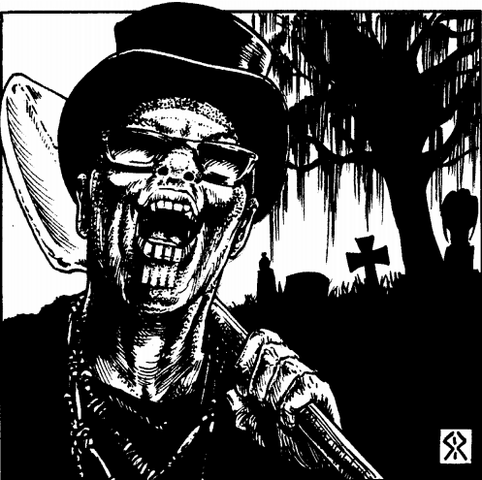
The Voodoo Pantheon
Or, in other words, some of the various loa/orisha. These are the big name loas/orishas whose names are invoked in the rituals of Voodoo Initiates. Loas, as well as other powerful spirits, have three stages of manifestation if they are called out: minor manifestations are on the edge of human and superhuman, moderate manifestations go fully into superhuman, and major manifestations are a sign to run away for everyone but the most powerful characters. When using someone as a Mount/Horse, the loa causes the possessed to manifest certain powers and physical boosts, but also causes them to act in a certain manner. Spirit Warriors gain the buffs but get to keep their minds for the most part, save for certain disadvantages or quirks they have to take to keep in tune with the spirit.
Legba: Papa Legba, known as Eleggua in Santeria and syncreticized with Saint Anthony in Catholic Voodoo traditions, is the lord of the crossroads. He is given notice before any other loas are interacted with, and his position at thresholds and barriers such as the one between the spiritual and material worlds mean In-Betweeners earn his ire as usurpers of his domain. While he resembles a frail old man hunkered down on a cane, Legba is actually one of the strongest of the loas, and in Santeria he is seen as a spirit of war as well as thresholds and knowledge. You can call on Legba to open many doors, as he is capable of imparting exceptional talent at picking locks, bypassing electronic security, or hacking computer systems. Mounts of Legba gain prodigious strength and act like an elderly man, sometimes spasming or going stiff.
Damballa and Ayida-Wedo: Damballa the sky father and Ayida-Wedo the rainbow serpent are a coupled pair of loas who always appear together. The wedded serpents bring forth prosperity through material wealth, passionate love, and fertile water and plants. If manifesting, Damballa appears as a grand serpent such as a python or king cobra, while Ayida-Wedo streaks forth as a rainbow-colored serpent of energy. Mounts of the pair become strong, swift, talented at swimming and climbing, and either climb to a high perch or sway in place; they never speak, instead hissing like a snake or making clicking noises. Even a Spirit Warrior cannot fully overcome the urge of the serpent, and speaks in slurred hissing sentences.
Erzulie: Erzulie (or more accurately Erzulie Freda) is the loa of beauty, sensuality, and femininity, coming to people in the dream world to seduce them or dominate them. She can also take the form of a mother whose "beauty is marred by savagery and madness" and a vengeful crone who dual-wields snakes as part of a maiden-mother-crone triad – these are references to actual loas in the Erzulie family, albeit reductive in nature – but rarely does so. Those made Mounts by Erzulie gain one of the three affectations from the quote I used to open up this post and act in a stereotypically feminine way and engage in various erotic maneuvers, and gain a bit of a boost to Strength and Dexterity, minor damage resistance, and a lot of the Charisma advantage. Spirit Warriors of Erzulie are also saddled with the Lecherous disadvantage, and must wear makeup and women’s clothing regardless of their gender as part of their oath.
Obatala: Obatala the Sky Father is our first orisha of Santeria and Candomble, the god of creation and spiritual purity. In Yoruba tradition, human atypical genetic conditions such as spinal deformities and albinism came into existence because Obatala was drunk on palm wine during one of the days he was making humanity from clay, and as such he considers them his sacred children in penance. While this story isn't mentioned in GURPS Voodoo, the book nonetheless notes that Obatala is fond of albino people and often takes them on as Spirit Warriors. Mounts of Obatala get some extra Strength and Health, damage resistance, and immunity to disease, and only wear white clothing. His Spirit Warriors always wear white as well, and are obsessive about cleanliness.
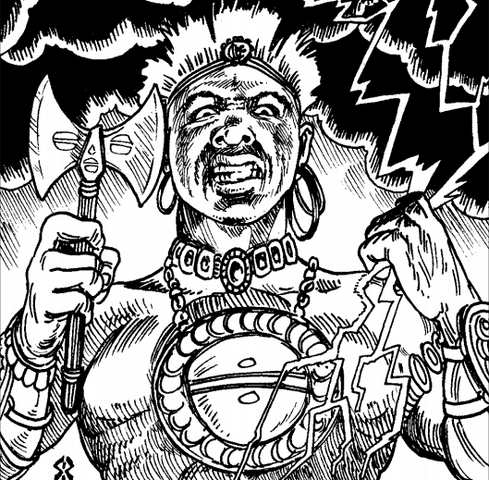
Chango: The loa of fire, volcanoes, and lightning, Chango is said by some Voodoo Initiates to be one of the gods of modern science as well. He is both a lover and a fighter, going at both with full force, and is usually wielding a sword or double-headed axe. If you need something done with fire, electricity, firearms, or explosives, he's your loa. Chango's Mounts are very strong, durable, and swift, and they both speak with a booming voice and perform dangerous acts with hot objects without coming to harm. His Spirit Warriors become lecherous and ill-tempered.
Orunla: Another orisha of Santeria, Orunla is rarely encountered. This mysterious spirit of time and divination resides in the dream world as a presence consisting of memories of the past and visions of the future constantly rolling together in a tumultuous fog. He spends most of his time chatting about matters of philosophy and fate with Legba, and unsurprisingly doesn’t take on Mounts or empower Spirit Warriors. He can be channeled to let his voice be heard, however, and you can implore him to give you a helpful vision.
Ogun: Ogun, or Oggun, is a particularly widespread spirit, being found in the religions of both the Dahomey and Yoruba peoples, Vodou and its offshoots, and Santeria and Candomble. He's a powerful warrior who has dominion over fire, smithing, metal, technological advancement, and self-powered vehicles. While violent and impulsive, he is also thoughtful and passionate, and is called upon alongside Legba and Ochosi to ward off disease and curses. Those that are Mounted by Ogun become strong, swift, and fit, and begin to wave around the closest weapon (or nearest thing that can be improvised as one) while swearing up a storm and affecting the mannerisms of a soldier. His Spirit Warriors must take on a hefty social burden, becoming bloodthirsty, overconfidence, and prone to constant profanity.
Ochosi: The orisha of hunting, wild places and the life therein, and healing, Ochosi's a pretty good guy to have on your side. He's not a particularly big fan of the Lodges, but he hates Corruptors with a burning passion, and is willing to let his followers work with Lodge members if it means the successful destruction of a Corruptor. Ochosi doesn't Mount people, but is willing to impart his power to Spirit Warriors, giving them greater strength, agility, durability, and spatial awareness, skills in surviving in the wilderness and tracking both creatures and people alike, and adeptness at using throwing weapons. The Spirit Warrior becomes both impulsive and overconfident, however.
The Guede Triad: The last entry in this section actually covers three loas that have the same manifestation stats and mostly similar mechanics otherwise. You've probably heard of one of them already: Baron Samedi, the loa of death whose undertaker-like outfit and white skull facepaint belie the fact that he's a crude and jovial figure who is fond of practical jokes, alcohol and cigars, and making lewd jokes. Also present is Baron Cimitie/Cimitiere, who puts on an affectation of aristocracy in spite of having the same crudeness as Samedi, and Captain Zombi (who I’m assuming is supposed to be Baron La Croix, the last of the three traditional leaders of the Guede), who sometimes wears military formal wear and is generally a bit less rude than his compatriots. Those Mounted by the Guedes gain prodigious strength and durability and are party animals who love to make obscenities, steal food and drink away from people holding them, and generally enforce the idea that life's too short to not live it up. Some resent Baron Samedi, however, for the fact that his image was used by Papa Doc Duvalier and his cronies. A Guede's Spirit Warrior is a liar, kleptomaniac, and obscene to a fault, but their acceptance of the inevitability of death makes them one of the most fearless warriors against In-Betweeners and Corruptors.
Next Time: Western spirits, angry spirits, evil spirits, and not-quite-spirits.
"The addict feels a surge of almost sexual pleasure as the fleeting spirit of his victim momentarily touches him"
Original SA post
Part 7: "The addict feels a surge of almost sexual pleasure as the fleeting spirit of his victim momentarily touches him"
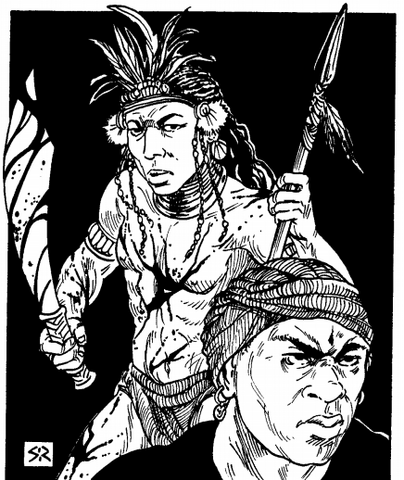
Chapter 4 Continued
The Mayombe
Named after the Kongo-descended Cuban religion of Palo Mayombe, the Mayombe are Voodoo spirits that have been tainted from their original form and become Corruptors. Apologies to Alien Rope Burn, as I’ve decided to steal their cultural footnotes concept given how far some of these guys go from their source material compared to the Voodoo pantheon of the previous post.
Zarabanda: God of destruction and war, Zarabanda became a Corruptor through worship by Red Sects. Human sacrifice is involved in his magic rituals, and numerous serial killers worship him. Those unfortunate enough to become his Mount are extremely strong and durable and go on a streak of mutilations, murders, and cannibalism, and his Spirit Warriors due pretty much the same thing out of their own will.
-Cultural Origin: Zarabanda, or Sarabanda, is the Kongo god of war, strength, and metal, and is likely to be a regional variation on Ogun.
Ikku: Ikku is a merciless specter of death, bringing with him disease, destruction, and general suffering. Most of his modern cultists are either bokor or members of inner city gangs, and his favored tribute is unsurprisingly human sacrifice. Prostitutes and the homeless are particular favorites. His Mounts become swift, strong, and durable sadists who sneak up on people and stab them with knives, and his Spirit Warriors have to make at least one human sacrifice a month to keep in his grace.
-Cultural Origin: Iku is the concept of death itself. Rather than being some evil monster, however, he's more of a cosmic tax collector: everyone's gotta die, and it's his job to make the rounds and get people to pay their final toll.
Mbua: Known as "the Killer", Mbua is a patron god of cannibals, serial killers, and assassins. People killing other people is what makes him happy, and he's probably behind that serial killer fraternity mentioned a few chapters back. Mbua never takes Mounts, but his Spirit Warriors are basically Zarabanda's plus the added bonuses of having great reflexes and a near immunity to pain.
-Cultural Origin: Mbua is the general term in Palo Mayombe for evil spirits. So that one pretty much stays the course.
Kiyumbe: One of two Corruptors that are a group of minor spirits rather than specific powerful entities, kiyumbe are ghosts created when a bokor calls forth a soul from a recently buried corpse and then proceeds to enslave and brainwash it into a murderous undead assassin. Kiyumbes without a controller for whatever reason gather in places of suffering such as prisons and insane asylums. Kiyumbes that possess the living cause the possessed to go berserk and assault all those around them in a frenzied state.
-Cultural Origin: This one seems to be fully the invention of GURPS Voodoo, as I couldn’t find any references on kiyumbe besides GURPS and a type of African flowering plant.
Nkisi: These guys are bokor's familiars, spirits with great strength, speed, and intellect that takes the form of a cat, dog, rat, or snake so that it can masquerade as a pet. Some nkisi also strike out on their own, possessing the head honchos of street gangs and drug cartels.
Cultural Origin: Nkisi's the collective term for any spirit in Kongolese religion and Cuban Palo.
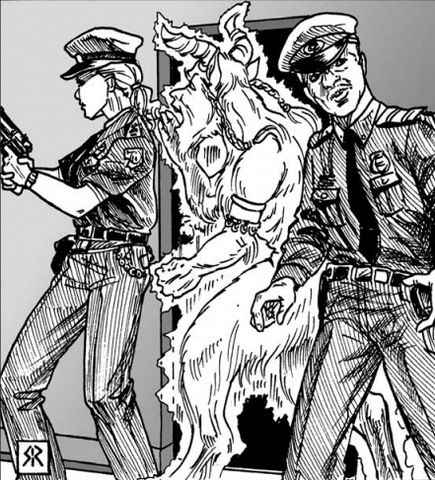
The Pantheon of the Lodges
While it is noted that there are some Lodges that worship the gods of the ancient Egyptians, Celts, and Norse, all the spirits presented here are either Greek or Gnostic in origin.
Abraxas: A god entirely concerned with the metaphysical world, Abraxas is not one to Mount mortals or empower Spirit Warriors. Instead, the enigmatic deity challenges Initiates to overcome their physical boundaries and achieve gnosis, coming to them in the realm of dreams as a limbed snake or being of pure light. The Ophites in particular worship Abraxas as the Serpent of Eden, and they and many other Lodge Initiates call upon Abraxas for rituals of warding or divine insight. Some Schismatics, however, claim that Abraxas is actually a Corruptor, hiding his dark deeds behind a mask of impartiality.
-Cultural Origin: While Abraxas wasn’t associated with the Serpent venerated by the actual Ophites and the form he is depicted in is usually that of a man with the head of a rooster and two snakes in place of legs, everything else here is relatively consistent with Abraxas as viewed by early Gnostics.
Pan: Pan, the satyr god of old, has an odd history with the Lodges, being publicly shamed as the Devil by the Roman Lodge's Catholic Church while in secret they and other Lodges continued to worship him. He is the patron god of the Crowley Society, whose Initiates surround themselves with satyrs (actually minor manifestations of Pan rather than their own category of spirit), and one of the only male spirits that is called upon by the Servants of Hecate. Pan and his satyr manifestations can spread lust or let out a shout to strike fear in the hearts of mortals, and when Mounting someone he makes the possessed a lecherous party animal with a fair bit of strength, flexibility, musical talent, and sex appeal. His Spirit Warriors have the same lecherous party animal habits willingly.
-Cultural Origin: Well...it's Pan. It's kind of hard to mess up Pan. He even has the panikon deima, his shout of fear.
Animae: Animae (singular anima) appear as either stereotypical Medieval Church art-style angels or as glowing white beings, and act as the intelligent and unwaveringly loyal servants of the Lodges. The Lodges’ wealthy chapters typically have animae constantly guarding their estates, and its strongest Initiates are usually in the company of a few acting as bodyguards. Animae do not convey their power to Spirit Warriors, and being possessed by one only grants minor strength and agility.
-Cultural Origin: The anima is the Latin name for the spark of life.
Daemons: Hulking faceless humanoids in heavy armor, daemons are brute force servant spirits that are typically used to smash things. Daemons can be ordered around by an animus, allowing the Initiate to command animae who in turn have troops of daemons under their own command. As with animae, daemons cannot bestow power upon a Spirit Warrior, and their possession grants minor strength, agility, and endurance boosts.
-Cultural Origin: Varying spirits below the gods, daemons in Greek mythology are parted into malevolent (cacodaemon) or benevolent (agathodaemon) entities.
Genii: Every individual has a genius, a guardian spirit that resembles an idealized version of the human they are tied to. The vast majority of Spirit Warriors within the Lodges utilize the power of their own genius, grantin them significant boosts of Strength, endurance, and agility. They’re quite important to keep safe, however, as a dead genius is extremely hard to replace – a new spirit has to be attuned to both you as an individual and to your entire spiritual bloodline.
-Cultural Origin: Genii in Roman tradition are guardian spirits that are tied to people, places, and things.
Demiurges: The demiurges may or may not be the actual demiurges of Gnostic faith, as the Lodges simply gave that name to Western Corruptors without putting much thought into whether or not they fit the label. Like other Corruptors, they hate humanity and want them to suffer and die, they're the enemies of justice, yada yada etc. etc. blah blah blah.
-Cultural Origin: The Gnostic Demiurge goes by a variety of names, including Saklas, Yaldabaoth, Samael, and YHVH. Birthed without the approval of the great divine oneness of the Monad, the Demiurge was wreathed in ignorance of the world above him and created the material universal to rule over as a god. He is a blockade between humanity and gnosis, and the goal of Gnosticism is to pierce through the Demiurge's veil and achieve knowledge of the spiritual existence.
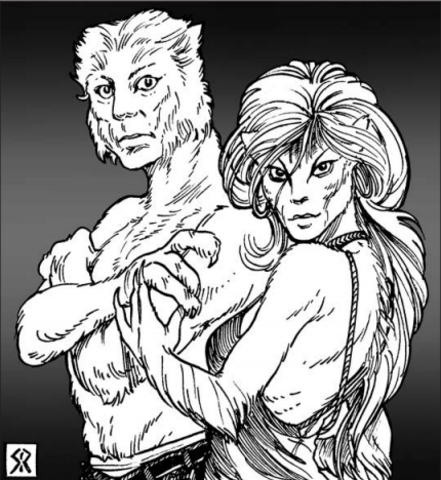
In-Betweeners
As stated in previous chapters, In-Betweeners are entities that are not quite spirit yet not quite mortal either, filling out the role of what would be referred to as monsters in most games. The origins of In-Betweeners vary, from souls that were “damaged” in the reincarnation cycle to the result of an animal and human soul merging through some strange happenstance or ritual, and some are even just born spontaneously. While corporeal, In-Betweeners can see spirits as well as physically harm them and vice versa. They "feed" on human emotions rather than material sustenance to live. Most In-Betweeners (read: all of the ones in this book, but the caveat is still given to make ones that don’t) have "In-Betweener Invulnerability", which means they have no organs, take the bare minimum damage from bullets and stabbing attacks, and generally have to be thoroughly pulverized if you want to truly kill them. With one exception, the In-Betweeners here are all based on mythological archetypes rather than a single monster from one particular lore. In random statements from other GURPS Third Edition books, the Minotaur of Crete, loogarou of Haitian mythology (and the werewolf legends it evolved from), and faeries of Europe are given as some other examples of In-Betweeners.
Bird People: Strong, swift, and ruthless, the bird people are humanoids with wings attached to their arms, heads of birds of prey, and vicious talons. They are found naturally in the forested mountains of the Caribbean, but have also appeared in urban areas of the United States and Canada, where they nest atop tall abandoned buildings. Appearing under the cover of darkness, they murder at least one person a week, as failing to do so mentally ails them and eventually causes them to die as well; in rural Haiti, children are told that they mustn’t wander off at night, lest the bird men come down from the mountains and take them. When taking human form, bird people usually disguise themselves as homeless vagrants, allowing them to slip through society mostly unnoticed. Some rare bird people are able to cleanse their souls and lose their bloodthirstiness and need to murder, and if you can convince them these guys make loyal guardians.
Cat People: The cat people hail from central Africa, but many took human guise and moved with the Trans-Atlantic Slave Trade to start new lineages in the New World. Unsurprisingly, the humanoid cats are exceedingly flexible, agile, clever, and sadistic, and have the ability to take the form of a human or housecat. They literally get horny from sensing pain, as well, and the most villainous of their breed take part in snuff films and child pornography.
 More regularly villainous ones take place in other types of porn or become drug enforcers, and a scant few can overcome their sadistic natures and become not-horrible people.
More regularly villainous ones take place in other types of porn or become drug enforcers, and a scant few can overcome their sadistic natures and become not-horrible people.Skin-Changers: Perhaps some of the most terrifying In-Betweeners, skin-changers are ageless murderous monsters who resemble people that have had their skin removed to reveal everything beneath. While they cannot innately shapeshift like many other In-Betweeners, skin-changers get around the whole "is a horrifying walking beast of revealed muscle and fat" issue by being able to assume the form of someone whose flayed skin they have taken. The oldest skin-shifters have prodigious collections of preserved skins they use in their day to day routines, which usually consist of being manipulative masterminds behind various criminal enterprises. Not scary enough? Well, lucky you, skin-changers are also agile, smart, endurant, and super-strong, regenerate wounds in the blink of an eye, and naturally have the powers of a Third Level Initiate! If you couldn’t guess, these guys are supposed to be end game threats for high point parties, and they are neither playable nor redeemable.
Snake People: In their natural form, snake people are scaly humanoids with yellow irises, slitted pupils, long forked tongues, and viper's fangs. They like screwing around with humans, either turning people against each other or doing old fashioned kingmaking (with themselves or their immediate servants as the kings, of course), and also habitually murder like many other In-Betweeners. As the Ophite snake people show, however, some can move beyond these urges and redeem themselves. As with skin-changers, Snake People never die of old age and innately have the powers of Third Level Initiates, but are otherwise less powerful. They've got more modest boosts to their stats, regeneration that works on a scale of minutes rather than several times a second, and have hemotoxic venom. In addition to a human form, snake people can turn into any snake species they know about.
Tontons Makouts: The angry, brutish ogres known as tontons makouts (singular removes the S from each word) aren't particularly bright, but they make up for it with prodigious strength, thick hides, and a near imperviousness to pain. They have foul tempers, gluttonous appetites, and love to kill people. Papa Doc Duvalier named the enforcers of his dictatorship after these monstrous In-Betweeners, and some of the real deal were even in his service. Most were wiped out after Duvalier fell from power, but some still lurk in the dark places of the Caribbean or followed their Red Sect masters in retreat to America.
-Cultural Origin: Tonton Macoute, meaning "Uncle Gunnysack", is a boogeyman figure from Haiti. This unpleasant ogre stuffed unruly children in his gunnysack, hence the name. Duvalier actually did name his special enforcers the Tontons Macoutes, though I have the feeling that none of them in real life were supernatural beings.
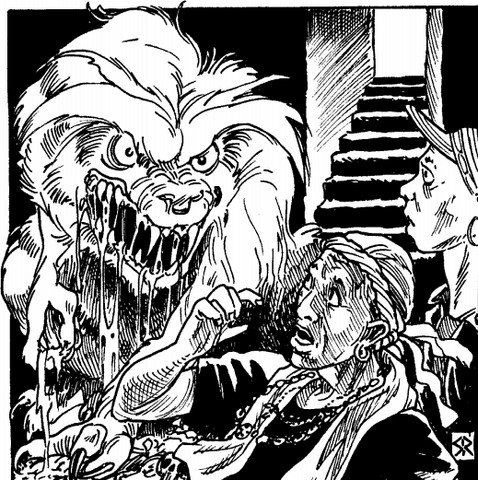
Devourers
Devourers are the eldritch horrors that sit at the top of the food chain of corporeal life, being to In-Betweeners what gods are to lesser spirits. They live under metropolises, but were there long before even the first founding stones were built, leading some to hypothesize that the Devourers draw people in to create cities they can corrupt. They have gigantic, monstrous forms with super-damage resistance and regeneration that would impress even a skin-changer, the ability to grow violent emotions in people for miles around their lairs, and deal double damage to spirits as a fuck you to any loas or other deities that try to oust them.
While that may seem to massive a hurdle to surmount, Devourers do have one fatal flaw: their Sendings. Sendings are In-Betweeners capable of taking any form that are created by a Devourer up to five at a time to do its bidding while it stays comfy in its lair. Destroying a Sending weakens the Devourer, and if the good guys can figure out that all the weird monsters lately have one single source, they can eventually cripple the Devourer enough to have a somewhat fair chance of actually defeating it.
Next Time: Why the Haitian Revolution was actually bad, and other items of questionable historicity.
"White sugar, the most addictive foodstuff ever developed"
Original SA post
Part 8: "White sugar, the most addictive foodstuff ever developed"
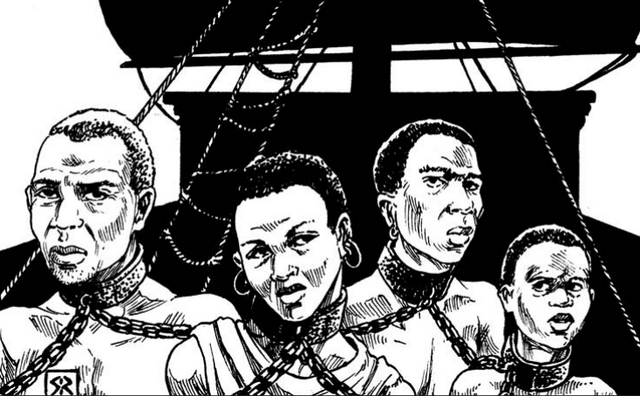
Chapter 5: Lands of Voodoo
History of the Caribbean
The penultimate chapter of GURPS Voodoo, Lands of Voodoo unsurprisingly focuses on the Caribbean, starting with a rough outline of its history...or the history as told by 1995 C.J. Carella, at least, which isn’t necessarily 100% accurate. I’ll freely admit that while I know some of what is wrong with this section, I don’t know enough about the history of the Caribbean before the Trans-Atlantic slave trade to go into massive detail, so feel free to give your own comments on anything that’s extremely wrong if you are more knowledgeable.
It begins in the pre-Columbian times, with the Taino and the Sea Caribs. The Taino were a group of peaceful indigenous peoples, living a semi-nomadic lifestyle of hunting and gathering as well as raising domesticated manioc (cassava). The Sea Caribs, by contrast, were a warrior culture descended from mainland South American tribes that engaged in both widespread slavery and ritual cannibalism. The Aztec and Mayan Empires also existed, but they don't matter because they're not in the Caribbean and thus only get a brief mention as a rare trade partner for Caribbean tribes.
In 1492, a "misguided Italian adventurer" you may know as Christopher Columbus sailed in and set up shop in the name of Isabella I and Ferdinand II of Spain. Things didn't go well for the Carib-weakened Taino, with disease, slave labor, and guns decimating their already fragile numbers. A Dominican friar by the name of Bartolome de las Casas was part of growing opposition to this mistreatment, however, and suggested that the Spanish plantations and mines be worked by slaves taken from Africa instead. And thus the Trans-Atlantic Slave Trade was born. The British, Dutch, French, and Portuguese Empires wanted in on this action as well, and made their own settlements in the Caribbean and South America soon after.
On these islands, the planter culture and its cash crops reigned supreme, with African people suffering from the grueling oversea voyages on inhumane slave ships and at the plantation masters’ lashes. Class systems were developed from conceptual blood quantums, with terms like maroon, quadroon, and octaroon coming to exist simply to demarcate just how much white blood vs. black blood one had in them. Interracial people, referred to collectively as mulattos, were a middle class between the purely white and purely black, and racial animus between the mulattos and the black slaves was and still is heated. There was also a fair bit of piracy and privateering in the shipping lanes during the 16th Century, but this eventually ground to a halt as more and more imperial control over the seas was exerted.
Entering the 19th Century, things start getting more shaky for the imperial powers. Populist uprisings begin to form across the Caribbean and Latin America. The Spanish Empire in the New World fell apart island by island, and the French-owned Haiti underwent the Haitian Revolution, where slaves and Maroons (escaped slaves who formed their own communities in the wilderness) overthrew the aristocracy of the islands and formed their own sovereign nation. American forces would occupy Haiti from 1915 to 1934, where paternalistic racism was present, but this eventually ended and "a lot of positive results" came from the occupation in the form of improved healthcare, better roads, and a better organized society. For the rest of the 20th Century, it’s dictatorships, poverty, and general not-greatness that gets but a few sentences of text.

Caribbean Occult History
Rather than interweave the paranormal and historical parts of its history, a separate section of this chapter goes over that timeline from the perspective of the supernatural elements of the setting. Or parts of that timeline, at least, as there are four major beats of this two page long section: slavery, the Haitian Revolution, Papa Doc Duvalier, and Fidel Castro. For the first, the Trans-Atlantic slave trade is the second worst human sacrifice to the dark gods that has ever happened, the only worse on being the Holocaust. For the second, the Haitian Revolution was mostly the work of Maroon Initiates, who were able to rally the rebelling slaves and use their magic to overpower the technologically superior French. "As a symbol for African Americans, Haiti is both an example and a terrible warning", however, due to a dark legend. Dutty Boukman was the Maroon houngan who helped spark off the Haitian Revolution in both real life and the world of GURPS Voodoo. In GURPS Voodoo, however, things go a bit further than sparking.
After killing thousands of white slave owners, Boukman and his houngans force the hand of some of the French Lodge members left alive to: namely, sacrificing thirteen slaves to summon a Corruptor. The Corruptor claims it is willing to assist the French colonials as long as they let it live on the island forevermore. Scared to death of the rebels coming for their heads, the Lodge members accept. The Corruptor scares away the rebels' loas, causing them to lose that battle to the French. In retaliation, the colonials massacre black Haitians en mass, "making little distinction between rebels and innocent people of the wrong color".
After this defeat, the same Corruptor appears to the rebels, offering them the same deal it did the French: as long as it got to stay on the island forever, it would crush their foes. They agree, and the Corruptor goes to royally fuck up the Napoleonic Army with plague and disaster, allowing the Haitians to win the day. The Haitian Revolution wins the black people of Haiti their freedom, "but at a terrible price", as the Corruptor remains under the totally binding interracial pact it made and is the cause of all the poverty, hurricanes, and other woes of Haiti. The land itself is tainted forever by this ancient spirit. If this all sounds vaguely familiar, that may be because "the Haitian rebels made a pact with the Devil" is literally a claim made by several evangelical Christians such as Pat Robertson and Lowell Ponte. It’s always a fine line to walk between using conspiracy beliefs in fiction and accidentally promoting really horrible ideology, and in this case I feel Carella unwittingly stepped over the line.
The section on Papa Doc Duvalier reiterates the statement from last update that some of the Tontons Macoutes were actual tonton makout spirits, but now ups the number of them from a few of the organization’s members to "most of" them. It is also hypothesized that both Papa Doc and his son Jean-Claude (AKA Baby Doc) were either dark Initiates or directly Corruptor-possessed. It’s also stated that in retaliation for John F. Kennedy suspending financial aid to Haiti, Papa Doc used a powerful curse to force Lee Harvey Oswald to make the now infamous fatal shot in Texas on August 22, 1963.
Finally, we've got Fidel Castro. Rather than through his own charisma and the strength of the people, Castro's overthrow of the Batista regime was done through a pact with a Corruptor. The CIA being unable to kill him? Corruptor. Staying in power for so long? Corruptor. The Cuban Missile Crisis? You guessed it, Corruptor. In-Betweeners and dark Initiates run rampant, drug trafficking and terrorism are rife, and the Corruptors generally love Cuba and their servant Castro for it.
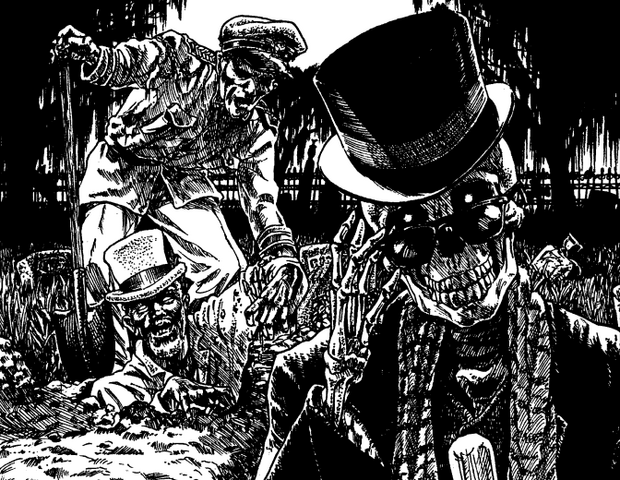
Chapter 6: Campaigns
The very final chapter, GURPS Voodoo ends off with the classic “so, what’s the GM going to do with all this information?” chapter.
Campaign Setting
The natural assumption for a GURPS Voodoo campaign is that you’re going to set it in either the Caribbean or urban United States, but what if you go off the script?
...No, not like playing on other continents besides North America, that would be silly! What we have here are suggestions on integrating other settings entirely. Want a Voodoo supers setting? Consider reading Marshall Law or George R.R. Martin’s Wild Cards for inspiration on the GURPS Voodoo cosmology in a supers setting! Cyberpunk? Street samurai melee fighting In-Betweeners and netrunners vs. e-Corruptors are go! Want to mix GURPS Voodoo and the
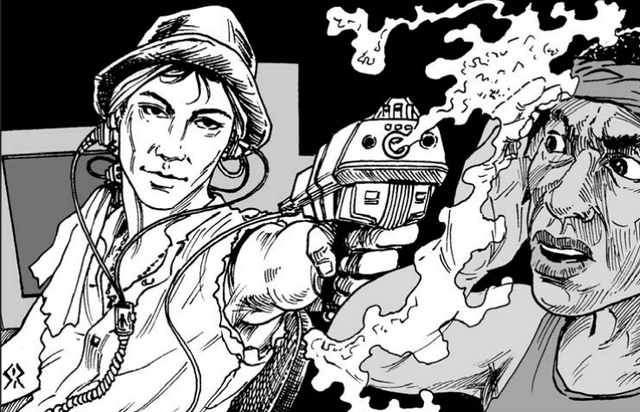
Time Period
While GURPS Voodoo is meant to be played in the current, very modern year of 1995, you can optionally set it in other time periods of the setting’s history. You could even go as far back as the Pleistocene, where Neanderthal and Cro-Magnon Initiates channeled totem spirits to survive in a harsh world. There’s also the possibility of the Crusades, where the Muslim Lodges, Byzantine Lodges, and western European Lodges were all at each others’ throats. Alternatively, you could go into a dark near-future (like the shocking future year of 2017!) where the Corruptors have won the fight and the world is an even shittier place. Most of this section, however, relates to the Golden Age of Piracy and the Trans-Atlantic slave trade onward. Since it’s mostly stuff we already heard in previous chapters, though, there’s not much to talk about and we can move ahead.
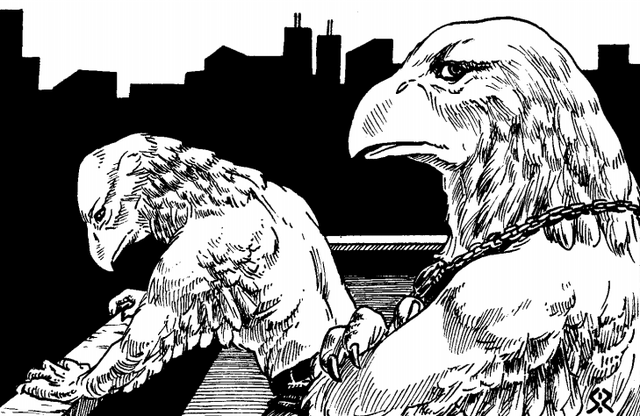
Campaign Style
This section is literally just an expansion of the point buy options from back in chapter 2. While this may be mostly redundant and possibly would have been better served by moving these more detailed overviews up into chapter 2, it at least does go over the benefits and drawbacks of doing the campaign in different ways. For instance, the 100 to 150 point scrubs tier of campaign is great for personal stories and people who think rather than fight, but it has a definite lethality not suited to all play groups and limits you to using the weakest spirits and cultists while ignoring the vast majority of the weird supernatural shit in the setting.
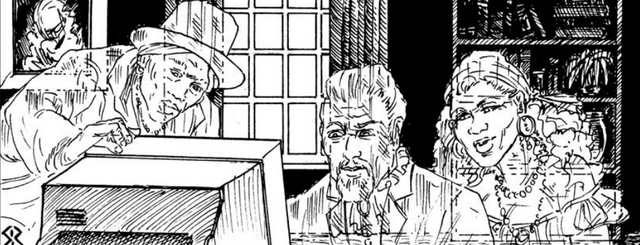
Campaign Themes
Last, but not least, GURPS Voodoo finishes off with a look at some thematic frameworks that help outline just what it is the players are going to end up doing. While one theme can be a campaign unto itself, the book suggests that having an adventure or two – hell, even the whole campaign potentially – reaching into several themes can bring more life to the players’ experience. Going over them briefly one by one, we have...
- Discovering the Conspiracies: The classic "uninitiated Average Joes and Janes get a rude awakening to the truth" style campaign. Your players’ characters start out not knowing anything about Initiates, In-Betweeners, spirits, or anything else related to the paranormal, and assuming they’re still alive by the end they still may not even know about things like the Lodges and Corruptors yet.
- War Against the Mayombe: The very direct monster-fighting game. The players are directly hunting the Corruptors and their servitors to make the world a safer place, one stopped cult or slain In-Betweener at a time.
- Voodoo vs. the Lodges: The "I want to directly get into the colonialism-related part of the setting" theme. The players create Voodoo or Lodge Initiates engaging directly in the struggle between African and European magical dynasties, though there is the possibility the campaign may morph into a more amicable situation once the party members' characters see the light of harmony and cooperation and all that jazz.
- Uneasy Alliances: The "my players can't unanimously decide between the two Initiate traditions" campaign. The party is a mixture of Voodoo and Lodge Initiates working together toward a common goal, usually related to In-Betweeners and/or the Corruptors.
- True Independents: The "screw the system, man" campaign. Forget the Lodges and the Voodoo bizongues, you're an independent Initiate! Players in this campaign are some manner of spontaneous Initiate, surviving member of a hounded mystic tradition, or some other manner of character that has an excuse for not taking sides between the Voodoo folks and the Lodges. They have to be especially careful, as both the monstrous servants of the Corruptors and both major Initiate organizations won’t hesitate to take them down a peg.
- I, Monster: The "guy who insists on bringing a copy of Savage Species to every D&D game you start" campaign. Everybody plays In-Betweeners trying to make their place in the supernatural world or stand up to the Corruptors and their frequently kinfolk servants, often with the angst that comes with being a horrible monster.
- Back From the Dead: As above, but with ghosts.
- The Paths of Magic: The "power, and those who seek it" campaign. Everything's about achieving gnosis and becoming the most powerful and mystically enlightened Initiate around.
Next Time: With the bulk of GURPS Voodoo covered, the only thing left to do now is to coordinate and give out some final thoughts before moving on to that certain other C.J. Carella-adjacent game once more.
The Wrapup
Original SA post
Part 9: The Wrapup
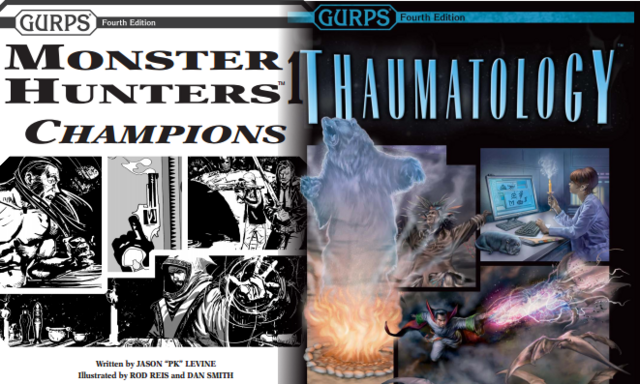
The Legacy of GURPS Voodoo
In spite of his insistence that it would happen, neither Carella nor any other author released further GURPS Voodoo sourcebooks in the years past 1995. It would receive very slight additions here and there, however; the books GURPS Who’s Who and GURPS Who’s Who II, for instance, would provide a few notes for the real world figures of John Dee, Bartholomew "Black Bart" Roberts, and Queen Ana Nzinga Mbande in the context of GURPS Voodoo. Its true legacy, however, would be in its magic system. Not only did ritual magic turn up again in further GURPS Third Edition titles such as GURPS Shapeshifters and GURPS Spirits, it would eventually make its way into GURPS Fourth Edition as well.
It first surfaced in the latest edition in 2008 with the publishing of GURPS Thaumatology, a book of various magic tweaks and alternate magic systems, where it commanded an entire chapter and was renamed Path Magic. The system mostly remained the same, save for increasing the number of Paths from five to eleven by adding six new paths: Cunning, Elements, Form, Gadgets, Knowledge, and Nature. An alternative Path system was also introduced in the same title, referred to as Book Magic due to each Path being related to a specific magical grimoire. Where things really kicked off, however, was a 2011 GURPS book called GURPS Monster Hunters: Champions. Written by Jason “PeeKitty” (his name as a ‘priest’ in the Church of the SubGenius, which he has decided to keep around as a nickname in production credits but usually shortens to just “PK”) Levine, GURPS Monster Hunters was a line of campaign workbooks meant to give GURPS players a quick reference for making their own settings in the vein of Buffy the Vampire Slayer, Supernatural, and the like. There’s a lot that could be said about that line, but we’re here for the discussion of GURPS Voodoo, so I’ll cut straight to the chase.
GURPS Monster Hunters’s magic system is dubbed Ritual Path Magic (RPM for short), and is yet another retooling of the ritual magic formula. Here, there are nine Paths: Body, Chance, Crossroads, Energy, Magic, Matter, Mind, Spirit, and Undead. The Paths also have alternate names based on nine of the ten sephiroth of the Kabbalist Tree of Life, hearkening back to the good old Gnostics again, but unless I missed something about casting fireballs and raising zombies in my time looking at Jewish mysticism the names are seemingly random. More importantly than its choice of Paths, however, RPM actually codified the further creation of rituals by adding various energy modifiers, qualifier of power level as “lesser” or “greater”, and seven keywords for specific types of ritual effect – those keywords being Control, Create, Destroy, Restore, Sense, Strengthen, and Transform – with all of these codifications having specific energy costs to add up and say exactly what your ritual’s value actually is. RPM would manage to rise to the top of the heap of fan-favorite GURPS magic systems and eventually gets its own setting-neutral supplement for those who didn’t care about Monster Hunters but wanted to use its magic system. I’d say that even though GURPS Voodoo itself never had any further sourcebooks, that’s a relatively big line of inheritance for it to have.
Closing Thoughts
What are we, over two decades and one shitty review later, to make of GURPS Voodoo? Is it an unfairly ignored masterpiece of a setting that fits up there with the legendary greats? Is it one of C.J. Carella’s masterworks, worthy of as much or more admiration than something like Terra Primate, Buffy the Vampire Slayer the Roleplaying Game, and indeed the Unisystem as a whole?
...Well, no. It certainly tries, though. And really, I’d say that’s the phrase I’d describe GURPS Voodoo: The Shadow War with as a whole – “it tries”. The goal of having a roleplaying game focused around people of color and a group of religions that are often demonized in European and American pop culture is a laudable one. Ultimately, however, this goal clashes with 90s liberalism and Iron Age comic book sensibilities, creating a world crawling with a hilariously high number of serial killers, drug dealers, pimps, and gangsters that are all literally demonic in nature opposed by a wizard Burger King Kid’s Club of those who have realized that maybe both sides are bad and we all just need to all come together and put aside things like the history of chattel slavery and institutional racism in order to stop the real metaphysical evil of the world.
Still, it comes from a right-minded heart, and in spite of my ire at some of its material I would ultimately give GURPS Voodoo the stamp of a flawed work with good intentions, and its underlying framework could be salvaged. To put the cards on the table, here's my own personal and heavily opinionated "four things that could be improved upon in V:TSW".
- Remove that line about the Corruptors supporting "ultra-conservatives and revolutionaries, racists (and reverse racists), misogynists and radical feminists, fundamentalists railing about “Satan-spawned” ideas and secular humanists undermining spiritual concepts". No, I'm still not over that quote.
- Human agency in acts of evil is clouded by the Corruptors being at the heart of every villainous idea in history, from Trans-Atlantic Slavery and the Holocaust to secret racist cabals and roving gangs of millions of serial killers that usually know each other. It's fine to have evil creatures being evil, and I'm not suggesting that there should not be any In-Betweener murderers or Corruptor plots or whatever at all. What I'm saying is that sometimes you should just let humanity's evil be entirely human and not pawn things off on otherworldly forces. Maybe even cut the Corruptors back further, having them be less the instigators of evil and more an ominous after-effect of our own sins.
- As was noted by commenters before, the dearth of coverage of Islam beyond placing it alongside Christianity and Judaism in the purview of the Lodges is unusual for a setting as heavily focused on black and Hispanic history in the Americas as GURPS Voodoo is. Hell, Christianity itself is kind of a big deal within that history as well, for that matter. It's tangled up in that whole very White Wolf-esque concept of monolithic Abrahamic villainy, which both muddles the idea that the Lodges are primarily white supremacists and limits the potential scope of Voodoo's protagonists.
- While Voodoo is right there in the title of the setting, it's kind of a shame that religions that aren't either Abrahamic, European, or derived from central Africa are lumped into an extremely briefly-described "other" category. Fleshing out these various groups in between the Lodges and the Vodounistas would be an interesting thing to delve into.